WHAT’S CHRONIC PAIN?
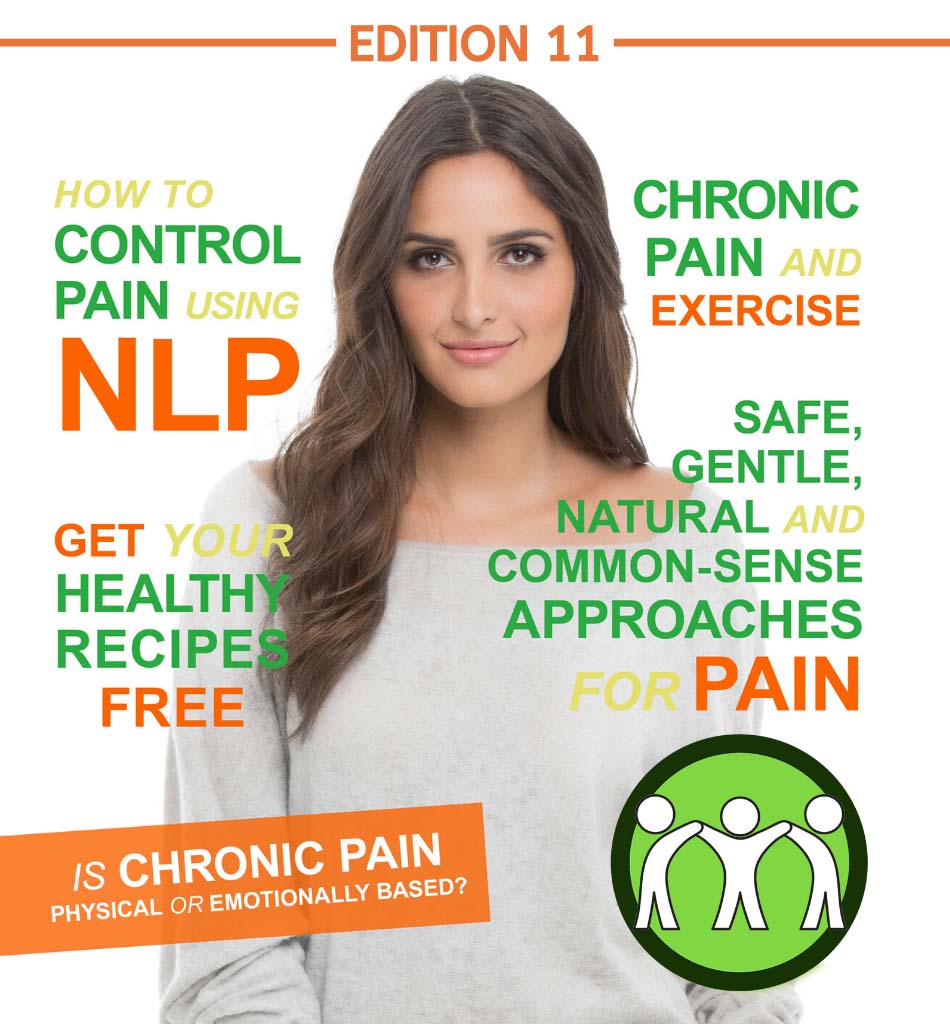
HOLISTIC LIVING |
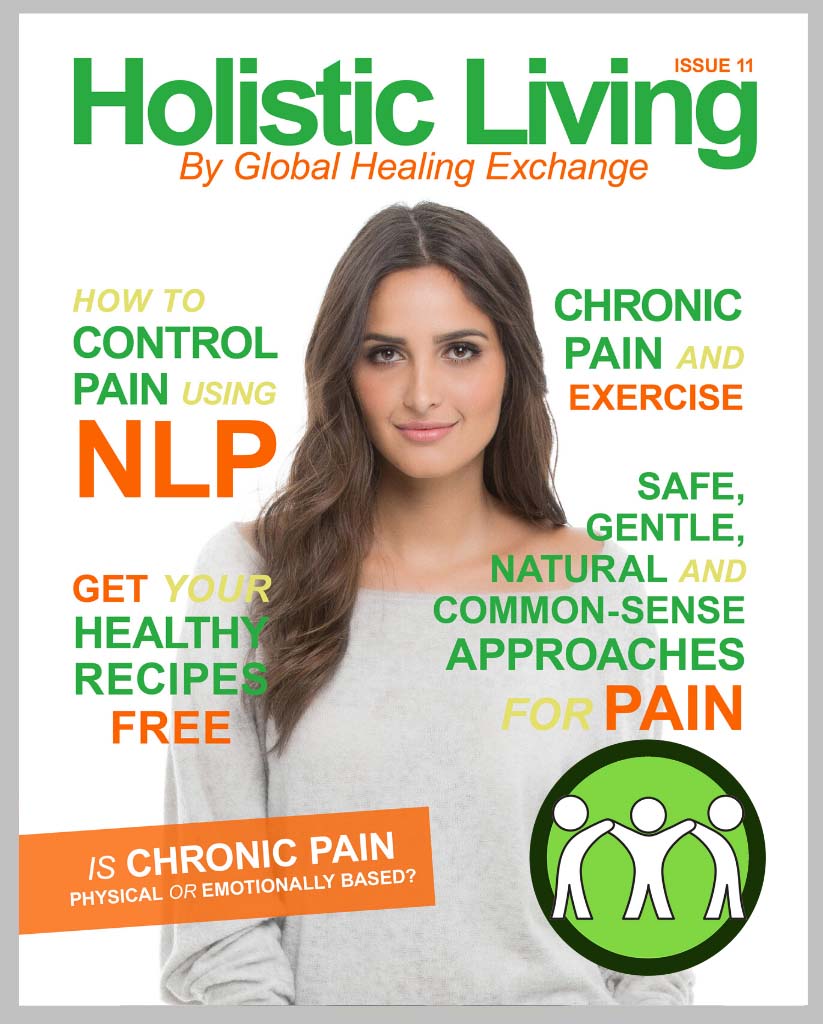 |
Editor in Chief Editor at Large Layout Artist |
If you want to advertise your business, product or service with |
What’s Chronic Pain? by Sharon White p.4 Homeopathy? Placebo? What? How To Control Chronic Pain Using NLP Painful Thoughts Why Disc Injuries Occur And How To Fix Them Is Chronic Pain Physical Or Emotional? Is CPS Like A Daily Whiplash? Chronic Pain And Exercise Dealing With Chronic Pain Eradicate Chronic Pain Using Safe, Gentle, Natural & Common-Sense Approaches Stop The Pain. I’m In Hell! Chronic Pain. A Naturopathic Perspective I Am Love |
What’s Chronic Pain?
In this day and age so many people are suffering from chronic pain. Chronic pain education is vital. Pain is your body’s mechanism to tell you something is wrong or not working. It is your body’s normal reaction to an injury or illness.
We have all felt pain from time to time and know that the pain goes away. Pain is a normal sensation that alerts us to possible injury or illness. When the core issue starts to heal, the pain starts to subside.
There are different types of pain. There is acute pain, severe pain and chronic pain.
Acute pain is a type of pain that typically lasts less than 3 to 6 months. Acute pain is directly related to soft tissue damage such as a sprained ankle or a paper cut.
Acute pain is of short duration but it gradually resolves as the injured tissues heal.
Severe pain means that you are unable to engage in your normal activities. A person with severe pain is considered disabled and unable to function independently.
Chronic pain is different. Your body can hurt for weeks, months or even years. It is often defined as any pain lasting more than 12 weeks, often for months or even longer.
There are different types of chronic pain, for example nerve pain, pain from bones, muscles and joints, as well as cancer pain. Chronic pain can be anything from mild to severe.
When you hurt for a prolonged period it affects you emotionally as well as physically. It can cause many issues, it can affect your mood and can lead to depression, trouble sleeping and stress.
In this magazine we want to give you strategies to manage your pain both on a physical and emotional level.
What’s Chronic Pain?
Pain comes from messages from your body through your nervous system. When you injure yourself the pain sensors in that area switch on, they send a message to your brain through your nervous system.
Once your brain gets this signal it tells you that you are in pain. What happens then is your body starts to heal the area that is in pain and the pain starts to subside. With chronic pain the nerves keep firing long after you have healed.
Chronic pain can occur in a variety of locations in the body and for many different reasons, patients and their health care practitioners need to work together to identify the causes and symptoms of that pain and how it can be managed.
When you have chronic pain it is known as a disorder called Chronic Pain Syndrome (CPS). This condition occurs in a wide range of other conditions.
Chronic Pain Conditions
• Arthritis
• Migraines
• Fibromyalgia
• Inflammatory Bowel Disease
• Endometriosis
• Chronic Fatigue Syndrome
• Past Injuries or Surgeries
• Back Problems
• Nerve damage
Many times, when you start to treat the root cause of these conditions, the chronic pain will subside.
Chronic pain is different in every single person. It can be a constant pain that is there daily or it can come and go. There are varying ways that the pain can show up in your body.
Chronic Pain Symptoms
• Shooting
• Squeezing
• Stinging
• A dull ache
• Throbbing
• Burning
• Soreness
• Stiffness
The goal when treating chronic pain is to reduce pain and improve function, so the person can resume day-to-day activities. There are many options for you to look at in order for you to make an effective treatment plan.
It is important to know that sometimes chronic pain can’t be cured, but chronic pain management is possible.
Our experts in this magazine will give you many options to manage your pain so you can experience chronic pain relief.
Enjoy.


Founder of Global Healing Exchange and Holistic Living Magazine
Please use the information you learn in these magazine as a guide.
This content is not medical advice and is not intended to replace the advice of healthcare professionals.
Always consult your doctor or other healthcare professional before beginning or making health changes.
You should never disregard medical advice or delay in seeking it because of something you have read in this magazine.
RETURN TO FRONT PAGE
Homeopathy? Placebo? What?
Did you know that, according to Wikipedia, Homeopathy is well over 200 years old , was invented by a German named Christian Friedrich Samuel Hahnemann and according to Wikipedia is:
“…not a plausible system of treatment, as its dogmas about how drugs, illness, the human body, liquids and solutions operate are contradicted by a wide range of discoveries across biology, psychology, physics and chemistry made in the two centuries since its invention…”
Furthermore many Homeopathic pills are:
“made from an inert substance (often sugars, typically lactose), upon which a drop of liquid homeopathic preparation is placed and allowed to evaporate. The process of homeopathic dilution results in no objectively detectable active ingredient in most cases…”
All of which does not make a lot of sense for an article on Chronic Pain relief. Really? What has Homeopathy got to do with helping pain suffering?
Let’s look at something else. According to the same August encyclopedia, Wikipedia, a Placebo is:
“A placebo (/pləˈsiːboʊ/ plə-SEE-boh; Latin placēbō, “I shall please” from placeō, “I please”) is a substance or treatment with no active therapeutic effect…”
And more importantly:
“The placebo effect is a pervasive phenomenon; in fact, it is part of the response to any active medical intervention. The placebo effect points to the importance of perception and the brain’s role in physical health…”
I’ll let Samy Hamdouche tell you the history of the placebo effect:
“Henry Beecher, an anaesthetist treating soldiers arriving from the front lines in Europe, was constantly short of supplies. As the legend goes, on one occasion Beecher had run out of morphine when a soldier needed to undergo emergency surgery.
Instead of administering the potent opioid, his nurse injected the soldier with a simple saline solution.
Remarkably, the soldier didn’t go into shock, nor did he gripe about the pain of the surgery. Beecher continued to administer the sham injection throughout the war while supplies of morphine were low, and found that it was 90% as effective as morphine at alleviating pain on the battlefront.”
So on one hand we have a statement that Homeopathy doesn’t work as it has no active ingredients, but a further statement saying that a Placebo, with no active ingredients, can work very well.
What if we take most of the things we know about Chronic Pain relief and turn them inside out and upside down? What if we start from a different point of view, that Chronic Pain can be a controllable symptom of an underlying cause?
What if something is seen not from quackery, such as Homeopathy is currently, but is seen as a Placebo equivalent as a way to alert and enliven the unconscious mind to improve your physical well being?
Whether you want to start from Homeopathy, or a Placebo, or better diet or plain old exercise to address Chronic Pain the fact of the matter is that “many approved pharmaceuticals address only the symptoms of an underlying disorder; symptoms are but tools of your unconscious mind to alert you to an illness. ”
And to alleviate the symptoms you do need to change things in your life. Luckily in this edition of Holistic Living Magazine you will find several wonderful articles on how to address Chronic Pain through a myriad of pathways and modalities. And that is your starting point.
But I will leave you with a final thought, again from Samy Hamdouche:
“The contribution of the unconscious mind to the observed action of a drug is significant, and in evidence-based settings it can be used as an ally to improve medical care, especially in the context of palliative care or neuro-psychiatric diseases.
Placebo will never shrink tumours or eliminate viruses, but if the ultimate goal of medicine is to ease suffering, then any practitioner could benefit from a healthy dose of perspective.”

Editor-at-Large
Please use the information you learn in these magazine as a guide.
This content is not medical advice and is not intended to replace the advice of healthcare professionals.
Always consult your doctor or other healthcare professional before beginning or making health changes.
You should never disregard medical advice or delay in seeking it because of something you have read in this magazine.
RETURN TO FRONT PAGE
Nature’s First Aid |
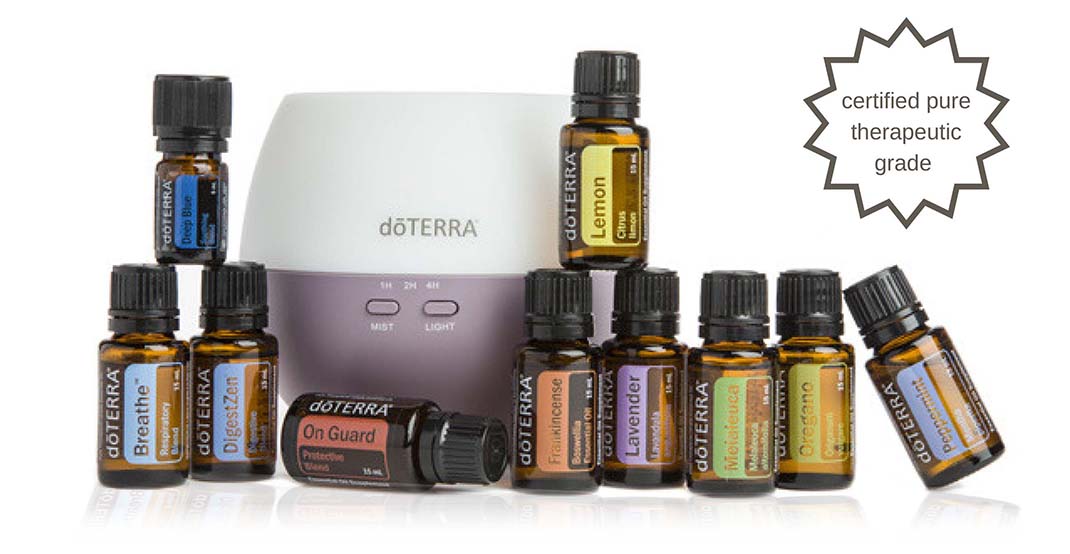 |
| ORDER YOURS HERE |
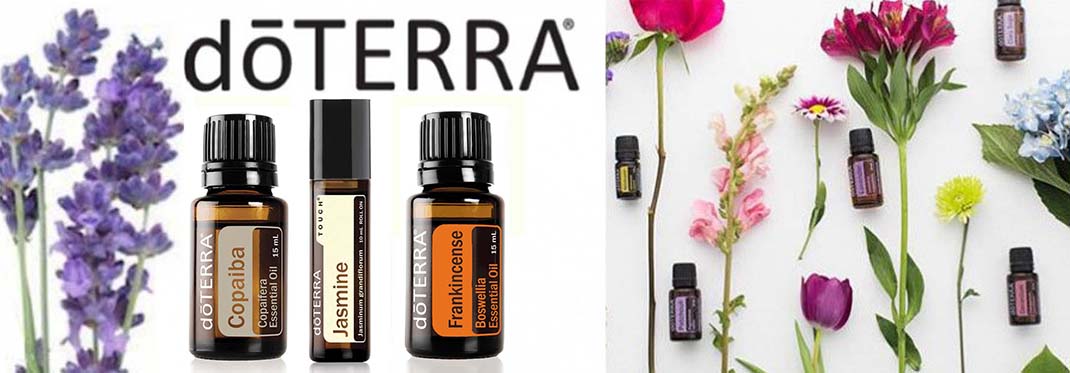 |
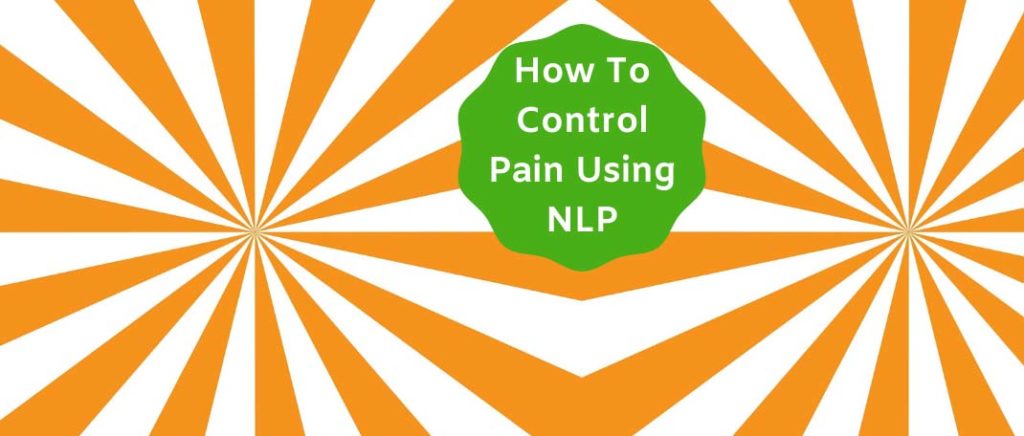
How To Control Chronic Pain Using NLP
NLP and hypnotherapy are very effective techniques for treating generalized pain, such as, migraine, headaches, cramps, etc. It helps to provide pain relief and pain control.
In this article you will see how you can learn to consciously alter your thought patterns that contribute to your pain, as well as to unconsciously turn these new patterns into automatic reactions that help reduce or eliminate pain.
I want to show you how to use a Neuro Linguistic Programming to change the way your mind interprets your pain signal. I mentioned how this pain signal works in my opening article.
You can learn how to reduce pain or even turn it off.
As you know pain is your body’s warning mechanism telling you something is wrong. It is extremely important to not turn off or reduce the pain without first identifying the underlying cause.
It is crucial that you learn how to speak to your body so you can understand its signals.
It is always good to consult with your health practitioner to find the underlying cause of your condition before embarking on reducing your pain.
How Can NLP Help?
The way you think controls the way your body reacts to certain stimuli. When it is acting in a way that does not benefit you, you can change it. This is where NLP & hypnotherapy come into play.
Imagine that you have filing cabinets in your brain. You have one for things you like, another for things you don’t like. Another for pain.
Another for pleasure. You have hundreds of filing cabinets. Now your brain stores all of these things differently when you look at them.
For example;
If you get a picture of a spider in your mind’s eye. Notice the colour. Notice the size of the image. Notice the feelings associated with it. Notice any sounds you hear. Notice any vibration or movement you feel.
Now if you like spiders this image will be OK for you to look at but if you don’t like spiders this image will be hard for you to hold.
Now when working with clients in releasing their phobias, we change the sub modalities of the image.
What do I mean by that? We change the picture that the client holds in their filing cabinet.
Here is an example of some sub modalities that you can change. See this image.
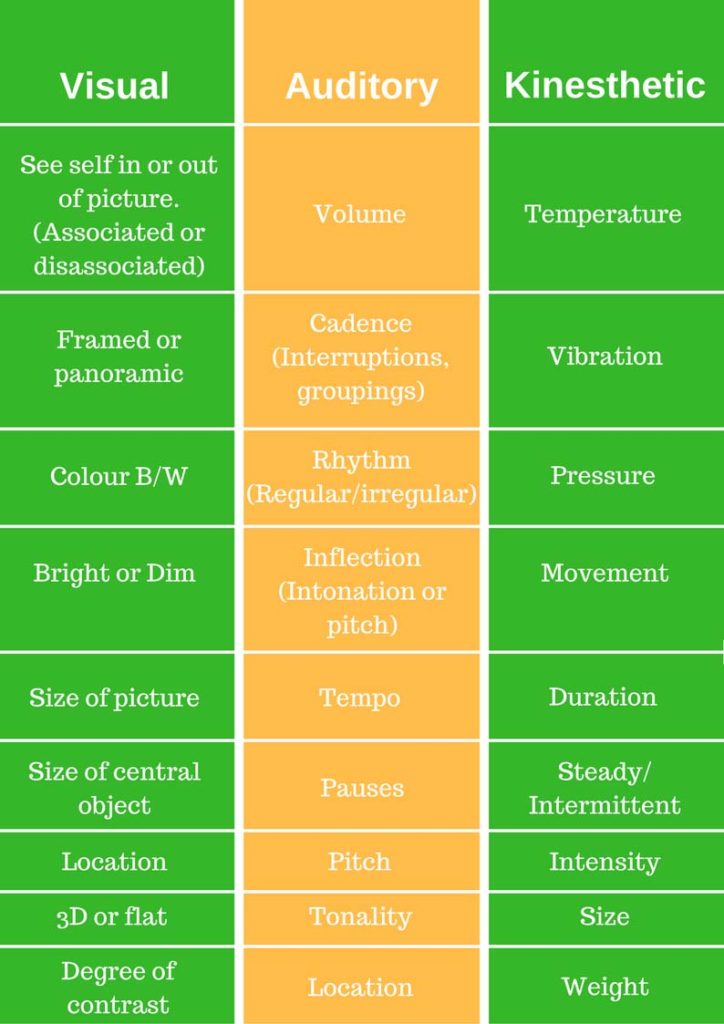 |
By changing the way you see the image in your mind’s eye, it will totally change the way you feel about spiders. This can work on any phobia and this technique can also work on reducing pain too.
Step One – Relax & Count Find a quiet place where you can sit and relax. Turn off your phone and make sure you will not be disturbed. It could be a beach, laying on the sand, listening to the waves gently crashing on the sand, going in and going out and every out breath helps you to fall deeper and deeper into relaxation. You could be near a waterfall. You can hear the water cascading down onto the rocks into the beautiful still pool beneath. As you relax you feel your breath and notice your chest, rising and falling, rising and falling into relaxation. You can think about words and phrases that help you to relax and repeat them to yourself telling yourself to breathe and relax. Talking to yourself in slow deep, gentle tones will help you to relax with every breath you take. Now count backwards from 5 to 1. 5…… 4…….. Telling your body and mind that you will be in a relaxed trance like state when you get to number one. 3……..2……….and 1. Feeling calm and relaxed now. |
Step Two – Observe The Pain When you’re relaxed observe the pain objectively. Think of it as a sensation. Now imagine it as if it has a physical existence. See it as on object in your mind’s eye. What shape is the pain? What colour is the pain? What texture is the pain? Are there any sounds associated with it? Is there any movement associated with it? See, hear or feel this image in your head clearly and let it become a metaphor for your pain. Take your time and you will start to see, hear or feel this image of pain in your body. |
Step Three – Move The Pain Move the pain image away from you by a couple of metres, so you can observe it easier. |
Step Four – Change The Sub Modalities Of The Pain See the image in front of you. Start making the shape different. The colour different. The sounds associated with it different. Make any movement that you felt different. Start to see and feel the difference as the shape changes now. You can alter the position of where the image is sitting. You can put it into your side vision, above your eye level, lower to the ground. Change as many of these sub modalities as you possibly can. When you experiment with this, see which sub modality change affects your pain and makes it start to decrease. Once the pain has decreased you can either push the image away out of your energy field or you can bring it to where it was originally in your body as the newer calmer image. |
Step Five – Increase Your Energy Pain takes away our energy and so we need to rebuild it. You can do this a few ways. You can move your body. You can dance. You can go for a walk. You can get yourself into a relaxed state. For this article (and because we are talking of NLP & Hypnotherapy) we will use relaxation to build your energy. Breathe deeply and get yourself into a relaxed state. Imagine a ball of yellow light around your whole body. Feel that ball of light vibrating around your whole body, filling your body with light inside and out. Filling your body with energy, inside and out. Notice the energy inside your body and outside your body. Imagine the colour of the yellow ball getting brighter and brighter. The vibrations inside and outside of your body is getting stronger. As you breathe out you can imagine the pain releasing and as you release send the pain out through your breath. Breathing in, breathing out. Breathing in relaxation, breathing out pain. Breathing in energy, breathing out letting go of pain. Here is a very simple technique that you can do anytime you need to manage your pain. You don’t need any special equipment. All you need to do is find somewhere you can sit down and close your eyes. I hope this technique works for you. It is the same with any visualisation techniques, the more you practice, the stronger they get. |

SHARON WHITE
Subconscious Mind Expert
Click here to work with me.
RETURN TO FRONT PAGE
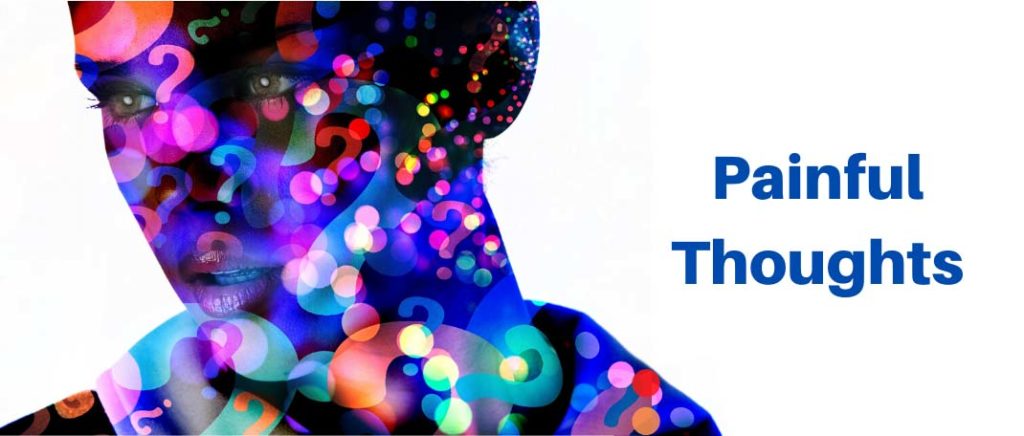
Painful Thoughts
What if… (Insert any worry/challenge/problem that currently occupies your mind).
We humans are masters of playing the what-if game. We do it constantly, sometimes consciously, and often subconsciously. As kids, this whole thing starts usually some time during our primary school years.
Once we have grasped the concept of rational thinking, we start playing it. Our mind gets stronger and we turn down the volume of our inner voice, of our soul.
Kids do what their parents do, and so as kids we copy the way our parents play the what-if game. Although our inner voice is turned to low volume, we intuitively get it when our parents stress or worry about something, even when they don’t tell us anything.
We start copying their coping mechanisms too, which often involve strategic thinking, thinking rationally through any worst case scenario, and rarely visualising a best case scenario…
Then we grow up, finding our space so we can fit into the frame of society, noticing that most people do play the what-if game on a regular basis, and mostly it is played about worrisome situations.
So we join in and follow the herd. Maybe at some point, we notice where we put our energy, and we re-evaluate.
And maybe we reconsider too, and we turn the game around into playing a positive what-if game, visualising only good outcomes and results for whatever challenges we are facing in life.
We have a choice about the thoughts we think. And we can restart our system every day, upon waking up. Even during the day, when we notice our thoughts feeding a mountain of worry rather than a sea of solution, we have a choice to refocus.
Acting out this choice means regular training, like visualising a switch we use, to switch the flow of our thoughts and energy towards joyful solutions instead of unbearable challenges.
This awareness of our thoughts is a process, which for many people requires a lot of patience and loving gentleness towards themselves.
Practising loving gentleness towards ourselves is not something we are taught in today’s education system. So we might need to dig deep to connect inwards with the concept of self-love, self-acceptance and gentleness towards our self.
When we consciously decide to focus on shifting our (often painful) thoughts, we set in motion a chain reaction, which might be visible and palpable on the outside, or we might not be able to see and feel it in our present life.
Often, in hindsight we see how much we have achieved by simply deciding to use our ‘think switch’ and to repeat this switching motion again, again and again.
One foot in front of the other, step by step, one moment at a time, all day every day…
As with any kind of training to become more experienced in something, frequent repetitions are the key to our anchoring this tool in our conscious mind. The side effects of the think switch might include us noticing a change in our behaviour in everyday life.
Or we might look at ourselves and the life we live from a different perspective. We might start looking after ourselves in a different (maybe more positive way), and we might find that through changing our active thoughts, our body is affected in a good way too.
The concept of body, mind and spirit cooperating on all levels as a team is worth looking into when it comes to painful thoughts and also chronic pain. Sometimes, our body creates chronic pain for seemingly no reason, and we still have a choice how to think about this experience.
We can use the think switch when in pain too. Our mind is a powerful tool, and when we use it to support the body, it can help us relax even while we are in pain.
It might support our practice of executing loving gentleness towards ourself, where before we succumbed into suffering. It might not lessen the physical pain at all, yet it might help shift our focus.
When a migraine attack hits me, and they have hit me on a regular basis for over 20 years, I now focus on consciously relaxing, lowering my (tense) shoulders and breathing deeply to slow down my whole system.
For me, my body is the extended alarm system of my soul. When I cannot hear my soul voice, my body starts giving signals.
Subtle signals to begin with, which I often ignore, even after so many years of training my mind to use the think switch and to also listen to my inner voice. When my mind receives the body signals, I have a choice how to respond.
I can either ignore the signals, or I can listen to my body. What does my body need now? For me, it is warmth on my shoulders and neck, it is lying down and sleeping – or I need to go outside and take a walk in nature.
Having a choice to actively exercise physically to release the pain is something I have taught myself over the years. For a long time, my only solution for treating my migraine was to lie down immediately and take a pain killer, and to yearningly wait for the numbness to kick in.
My changing process began when I actively thought ‘I am grateful for the pain killer working’. From there, I worked my way towards recognising my body-soul signals early, and to act accordingly, so I don’t need to take pain killers anymore.
Gratitude is one of my go-to’s when I use my think switch, and I use it often in many situations and challenges. It takes my mind and my whole system on a very different path than my self-chosen suffering did for such a long time.
I had become a very slick master of succumbing to suffering and pain, feeling quite alright being the victim of this darn migraine hitting me AGAIN!
Why, why, why me? Why do I deserve to be in such pain? Feeling immobile and so very limited when I suffered, disconnected from my soul quite some.
At present, I am still working on finding my personal balance between body, mind and soul. It is an ongoing process, and the migraines are taking up less space in my mind and my body than they have before.
I don’t know if they will ever stop or if they will be part of me for another twenty years, yet knowing I can use my think switch motivates me to continue on my quest of hearing my soul voice every moment of every day.
by John O’Donohue |
When the rhythm of the heart becomes hectic, The light in the mind becomes dim. Weariness invades your spirit. The tide you never valued has gone out. You have been forced to enter empty time. There is nothing else to do now but rest At first your thinking will darken You have travelled too fast over false ground; Take refuge in your senses, open up Become inclined to watch the way of rain Imitate the habit of twilight, Draw alongside the silence of stone Stay clear of those vexed in spirit. Gradually, you will return to yourself, |

Conscious Awareness Teacher
Click here to to find a practitioner.
RETURN TO FRONT PAGE
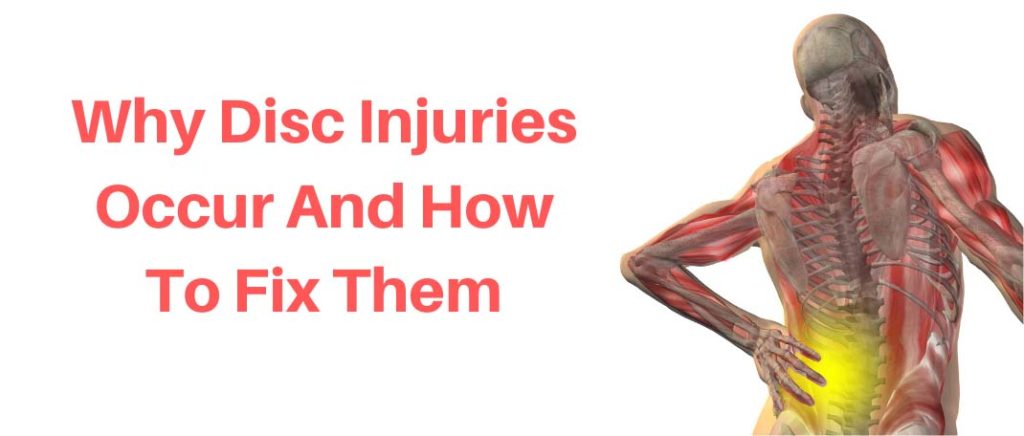
Why Disc Injuries Occur And How To Fix Them
Inter-vertebral discs are shock absorbers for the spine. Their inner is made of a gel-like substance called the nucleus pulposus. The nucleus has a high water content and is enclosed in a tough fibrous casing called the annulus fibrosis.
Together they cushion the spinal joints and allow space for nerves to flow out to control every part of the body.
This tougher outer casing of the inter-vertebral disc should hold and support all the inner substance of the disc material. It is then all held together by the surrounding ligaments and muscles.
Disc injuries (sometimes referred to as disc derangement, prolapsed disc, herniated disc or slipped disc) are extremely common. Many people walk around every day with a disc herniation that goes undiscovered until pain occurs.
The most common age for a disc injury is 30 to 50, but even teenagers can have disc problems. Symptoms can be a gradual or sudden onset of pain. This pain can be constant or intermittent.
The symptoms can range from pins and needles or numbness right through to debilitating pain which makes it difficult to move.
Pain can be local to the area or referred through the gluteus (butt) down through the leg and foot. Symptoms can be even or on just one side.
A general rule is that the further the symptoms travel through the limbs the more severe the problem. This can also depend on the amount of the gel like substance (nucleus pulpous) protruding through the harder casing (annulus fibrosis) and putting pressure on the nerve canal.
Why Do Disc Bulges Occur?
While accidents, knocks and bangs can cause disc injuries, they are more often the result of damaging long-term sitting, working or sporting positions along with weak supporting muscles.
The most common muscle imbalance associated with disc injuries is a flat or sway back position in the low back with a kyphotic (slouched upper back).
This generally includes tight hamstrings and glutes (butt) and a weak core/abdominal muscles.
This muscle imbalance puts a constant pressure on the disc that weakens it over time, leading to the disc material pushing outwards or sideways and pressing on the spinal canal.
Think of it like a hole in the toothpaste tube: if the toothpaste squirts out it is sometimes almost impossible to get back in.
And, if the problem is not addressed in early stages, sometimes surgery is needed. If the disc material has protruded a long way beyond physical repair, surgical intervention may be required.
A diseconomy is when a surgeon goes in, sometimes microscopically to minimise scarring and damage, and shaves off the disc material that is pressing on the nerves and causing pain. This can help relieve the pain but it does not fix the underlying problem.
Fixing The Problem
Disc injuries can be slow healing because of the limited blood supply in the discs.
Muscle imbalance and poor posture must be addressed and movement patterns re-educated from a neural level to get the body back to function and strength.
It is extremely important to do the corrective exercises that will centralise and stabilise the disc. Incorrect movement can push the body to more vulnerable positions.
Learning functional movement patterns gives a person strength and confidence to lift and move in the correct way so further injury can be avoided and lifetime activities can still be enjoyed.
Other factors of importance include staying hydrated to keep discs plump. Dehydrated discs are like flat tyres to a car – much more likely to wear faster or blow out.
As a disc dehydrates and shrinks it causes the surrounding ligaments to be loose (known as ligament laxity).
Correct nutrition and appropriate rest/sleep is also imperative for all healing.
Testimonial From A Client With Disc Issues – Fighting Back Against Chronic Pain
Chronic back pain was ruining Peter Chapman’s enjoyment of life. But within weeks of working with postural specialist Michelle Owen, he was back doing the things he loved, pain free. In fact, Peter felt ten years younger!
The 58-year-old had lived with severe pain for nearly two years, but it was a visit to doctor that spurred him into action.
“The doctor told me that to fix the degeneration in my spine, I would need an operation and they would insert pins between the vertebrae. I thought, ‘no way, that’s not going to fix the problem’, so I started looking for an alternative!”
No Relief From Pain, No Way To Live
Peter’s pain was constant – whether sitting, standing or lying, there was little relief. Not wanting to accept this as a way of life for years to come, with the outlook of a worsening problem Peter followed a chiropractor’s referral and went to see Michelle. He hasn’t looked back since.
“Michelle was great – she listened to me, did an assessment and put me onto a programme, quick smart,” Peter explains. “Within a few weeks my back pain had disappeared and I could do normal, everyday things again. It was liberating.”
As a trained CHEK practitioner (Corrective High-performance Exercise Kinesiologist) and an ELDOA (spinal decompression) and Myofascial stretching expert, Michelle identifies and corrects any imbalances that are causing her client’s pain and discomfort.
To help with Peter’s pain, Michelle focused on the fascia – the tough sheets of connective fibres that envelop and weave through every muscle, nerve and organ in the body and tie it together.
Using both Myofascial and ELDOA stretching techniques, Michelle and Peter began by stretching and lengthening his muscles and spine to open up the body’s fascia, normalise the tissue and make sure there was enough space for the spine’s discs to sit in the right place.
Taking Control Of Your Body
But Peter knew that while his pain had disappeared, the underlying symptoms were still lurking. The next phase of his treatment focused on mobility, function and strength in correct positions.
“I didn’t want to constantly be cautious about doing things; having to stop and think will doing this make the pain come back?”
Working in a largely sedentary job, improving Peter’s core strength was imperative to his overall wellbeing. Visiting Michelle twice a week, he’s now focussed on building up his core strength through skilled weight training.
“If you really want to gain control back over your body you’ve got to give it the tools it needs. By working on your muscle tone and building up core strength, you can hold your body together.
Give it the weaponry it needs to fight any potential problems before they happen.”
Michelle started building up Peter’s strength to make sure his muscles worked together and could support his body correctly.
Her forthright approach and motivating support, helped Peter immensely – or as Peter puts it, ‘she gets in tune with what you want and need to achieve from the programme, right from the outset’.
An Investment In Yourself
While Peter acknowledges working with Michelle is a time and financial commitment, to him it’s a no brainer for being able to live the normal lifestyle he wants without pain. He sees it as an investment in himself.
“I have never lifted weights as heavy as I’m lifting now, and I feel great – there’s no strain with the correct potions.”
“In fact, I only cottoned on after a number of sessions, that unlike going to the gym, working out with Michelle doesn’t hurt. I’ve never been in pain during any training session.”
For Peter, the treatment Michelle offers has surpassed his expectations and he referred a number of people to her.
“There’s no point in living in pain or with impediments. You’ve got to seek help and Michelle has the skills to get you living pain free again.”

Postural Specialist, Corrective High
Performance Exercise Kinesiologist
Click here to to find a practitioner.
RETURN TO FRONT PAGE
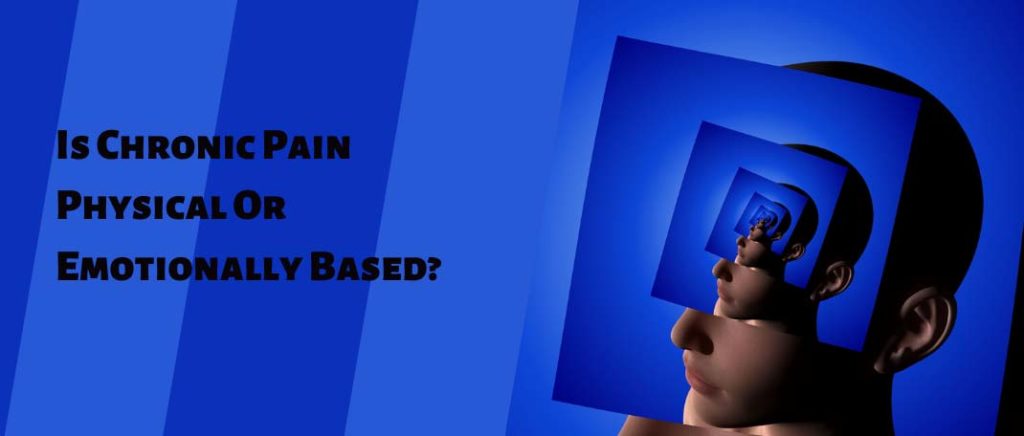
Is Chronic Pain Physical Or Emotional?
Are You Living A Life With Or Without Pain?
I must admit, I’ve been very fortunate and don’t get me wrong, I’m very grateful that I have never endured chronic pain.
I’ve experienced both physical pain and emotional pain. Something that is short-lived, (broken toe(s), injuries, falls, hurt of the heart (though some may say that can last forever).
But chronic pain is another level where whatever the condition, trauma, ailment etc, you are living with, it becomes part of who you are, it’s become your life breath, it’s felt, spoken of and you’ve integrated that within, which means it’s, all constant, all consuming, exhausting and relentless on your body, mind and your spirit.
I may poke the boundaries on this topic about chronic pain. I want to understand why there are some people that suffer levels of pain that can affect them to a point of being so debilitated they do not know what it’s like to be pain free.
Maybe they are bedridden, unable to walk without an aid. Constantly medicated to eliminate intolerable pain. To them it’s the norm and they feel that this is their life to this point.
They seem to age before our eyes, they lose all faith that they will ever be without pain! And others may experience lesser degrees of pain but with the same condition.
So how can a person suffer from chronic pain after an accident (say a broken leg, back, or some part of the body) or a genetically predisposed condition (such as osteoarthritis, childhood arthritis etc.) where they have required surgery, yet they are able to manage or cope through the pain, or even yet they heal quicker and their pain totally disappears?
Does it have to do with being in good physical shape or strength? Do they look after their bodies by taking care of their diet, being a vegetarian, not eating meat, taking vitamins, supplements, do they meditate and use positive thoughts and practices?
Seeing Physical Pain Come From Emotional Pain
A dear aunt of mine (now passed on 4 years ago) developed polio as a young child, and it affected one of her legs.
Back in those early days it wasn’t quite understood what the affects will cause, and they didn’t have the treatments like today. When I was a young teenager, all I remember was she had a slight limp and her foot and leg looked different and it started to affect her walking.
It gradually grew worse over the years. Her leg and foot swelled, changed shape, always quite large. She suffered with pain.
She grew up in the period where alcohol was her way of dealing with her physical and emotional pain, her father (my grandfather took his life due to being an alcoholic, before I was ever born) and her personal life was full of drama! (Oh, the stories to tell!)
As she grew older, the last 30 years of her life, she became a reformed alcoholic.
But it had taken its toll on her. She used a walking stick, walking frame, and then being confined to using a mobile scooter, her body endured the visible and physical signs of a person holding a lot of pain.
She was always saying, “Oh I’ve had such a terrible day, I’ve been in so much pain…” I know there was an awful lot of emotional pain she went through personally.
(Not like most people). But why did her physical body have to suffer this amount of pain for most of her life?
I believe her physical pain was a culmination of years of grief, from loss, hurt, deceit, punishment and anger. Her body used that torment and cruelly imprisoned her.
All Major Disease Has An Energy Pattern
Being an intuitive energy healer, I know how pain can affect our life. I believe that 99.9% of all physical pain results from an emotional base. Why do you constantly suffer back pain, headaches, or knee pain? Let’s look at this from an energetic perspective.
Is it an intrusion of some negative energy that has thrown us off balance? When we do not address emotional issues or traumas that have affected us at some stage in our life, I believe we take these on, not only emotionally but as a physical pain.
We are physical beings (on this earth plane) and our emotional health can take a battering. Let’s say you tend to develop relationship issues. You may not like to be alone, you feel like you need to be in a relationship, you have a need for affection, a need to be loved.
If you are feeling this way and you are filling a need (not positive energy) you will give too much energy of yourself to be in any healthy relationship.
Behaviours and patterns that keep occurring, result in the equivalent outcomes as you had before. If you try and work through whatever it is you are dealing with emotionally, and somehow you push the emotions down and believe you won’t put yourself through that situation again, it will fell like trying to put a bottle top on a volcano.
Somethings gotta give! And if you are vulnerable I believe it will affect you at your weakest point.
Genetics Or Past Lives?
We use the term genetics, referring to our DNA through our ancestors, but we also understand we can bring past life issues into this life too. In other words, past lives you’ve lived can affect you now and you may carry similar traits, characteristics that you lived in a past life.
Consulting a person’s Akashic or Soul records can also give possible solutions. Akashic or Soul records are a very detailed library of your life, from your thoughts, people you will encounter and what you signed up for to live in this or a past life.
Quite often I have people say, “But why would I want to sign up for something like that?” (lol)
Well that’s all part of your souls lessons of learning and to help you grow spiritually. It can even reveal many answers about unresolved fears, pains, and even major illnesses.
Is Chronic Pain Trapped Emotions In Disguise?
One nagging problem I had for many years (and I just pushed it aside too) was a pain I held in my left knee. Some days it was so sore and walking upstairs, I could hear it crunching.
I couldn’t pin point it, but I felt it was something within, not just a physical pain that could be fixed but something that needed to be released! I didn’t understand what it was until I learnt this…
The left side of our body represents the feminine, spiritual and moving forward. That made a lot of sense to me, I now understand this since I have been working with energy healing.
Clients come to see me with similar issues or conditions that need to be released and let go, so that they can move forward freely.
Using energy healing to shift pain, whether its chronic or not using the Forensic Healing modality is certainly a powerful tool to really get to the root cause of deep set conditions.
Since I started my journey discovering my ability to use energy healing to help others, I’m of absolute certainty, that this form of modality can enhance lives and the lives of all humankind!
| ~ I believe spirituality has shifted … it’s the new age of total embodiment. ~ |
| ~ Love, love is all, the beginning and the end, the alpha and the omega. Without Love there is no end. God is love. It is that simple, all heartache and complications is caused by man. ~ |
Forensic Healing is a proven therapy system superior to all healing modalities, because it:
• Profiles the client, identifying negative life patterns, archetypes, emotions, belief systems, and much more.
• Clears curses, negative energies, rituals, and many other spiritual issues.
• Activates spontaneous healing forces in the body for immediate changes.
• Removes the negative conditioning stored in the DNA or cell memory.
• Uses healing secrets from ancient healing scripts combined with the most-advanced scientific methods.
• Utilizes healing pathways that use physical, emotional, energetic or spiritual elements.
• Heals deeply at a soul level by targeting soul facets, fragments, DNA etc.
• Places a blessing on the client at the end of a healing.
• Educates and empowers the client to understand themselves so they leave with new information to progress in their life.
See Yourself Having A Dynamic New Experience
Please visit my webpage shonasoulsynergyhealing and check out my special package offers, when you choose to book and pay for a 3 session package!
I look forward to hopefully meeting you, joining your journey and helping you in any way to ride the waves of growth, new beings and this wonderful life we truly can find inspiring and inspirational!
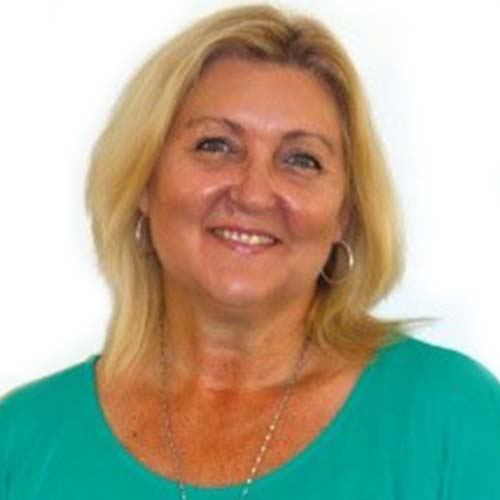
Forensic Healer
Click here to work with me.
RETURN TO FRONT PAGE
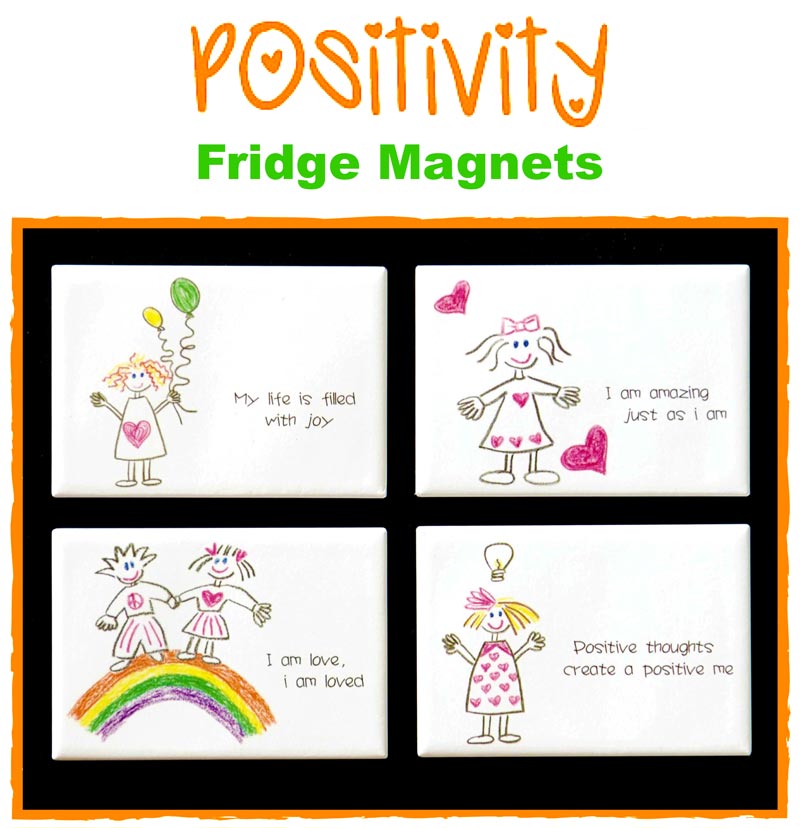 The Magnets Come In A Set Of 4 |
Positivity magnets were designed to inspire you on a daily basis to live your BEST LIFE and Every time you see them, (when you go to the fridge) they will inspire you to live a healthier life. The Magnets Will Inspire: · YOUR MIND – to think healthy thoughts – Positive thoughts create positive me We believe life is about having FUN and being as positive as possible. |
| GET IT HERE FOR AU$20 INCLUDING POSTAGE |
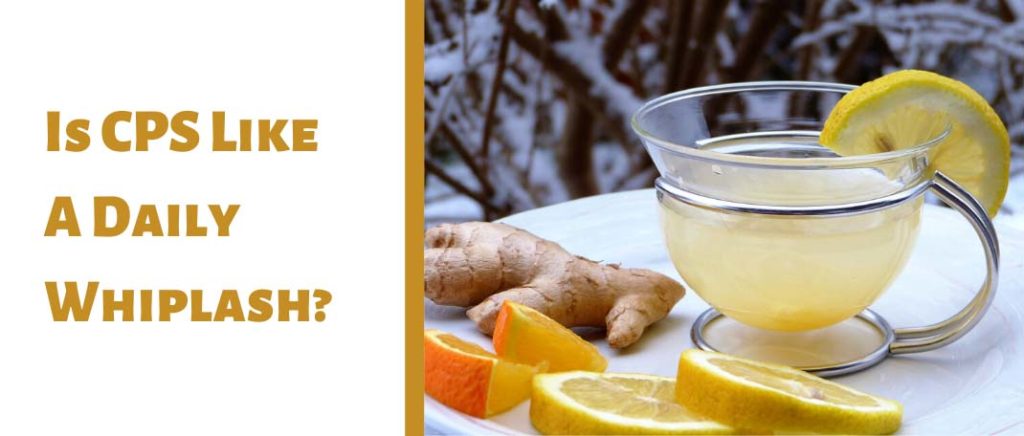
Is CPS Like A Daily Whiplash?
If you’ve ever had whiplash, you’ll recall the intense pain that radiates across the shoulders and spasms of pain that shoot down the spine.
Fortunately, with the right treatment and some rehabilitation you know it’s treatable and the pain will subside and you’re on the road to enjoying everyday activities.
But what if you had whiplash every day and you had to endure the intense shocks when you go to reach for your towel or bend over to tie your shoelaces.
Allow me to introduce you to CPS, Chronic Pain Syndrome.
Hundreds and Thousands of people all over the world are suffering from CPS and for many; it’ll be a lifelong struggle.
What Is CPS?
Chronic Pain Syndrome, or CPS is defined as pain in the body that lasts months and even years. Quite often the pain is from an old injury or recent surgery, persistent migraines and as we age, back pain and arthritis.
CPS suffers have said their pain can manifest from a dull ache to a stinging sensation, the area could be throbbing then they can experience a shooting stabbing pain that’s debilitating while others are experiencing ongoing stiffness and soreness.
Often CPS suffers say their pain lasts throughout the day while other CPS suffers have mild symptoms that don’t occur daily but several times over the month.
So you can see; CPS is complex and varied. Each CPS case needs to be handled with care and accuracy.
First Step To The Road Of Recovery
Your Doctor may suggest several approaches to identify where the pain is coming from; if you have neck pain, it maybe referred pain from your lower back.
Migraines could be a result of your shoulder so there are specialists that can ascertain where the pain is coming from and once identified, your first step to recovery is taken.
What To Expect
Depending on the type of pain you’re experiencing will determine the approach taken by your Doctor. Below are several types of testing chronic pain syndrome suffers may have gone through.
CT Scans
Computer Tomography Scan is a common and very effective procedure today. It delivers a cross section of your body.
Depending on your situation, the Doctor may want to see a little more detail so they may inject a fluid into your veins and this will show up on their screens a lot better.
MRI
Magnetic Resonance Imaging is an alternative to X-rays. MRI’s uses a large magnet to produce large detailed images. An expensive approach and people with pacemakers will need to use an alternative treatment.
Nerve Blocks
This is a very common procedure to experience when identifying pain in the body. Certain nerve endings are injected with anesthetic and your responses to the testing may determine the location of your pain.
Types Of Treatment
Most often, people today are opting for alternative approaches to their treatment of illness and wellbeing over the traditional medicated approaches often seen in society today and I applaud those people opting for a holistic approach.
I am a firm believer the body can be healed effectively with the correct nutritional approaches and having an active mind-body methodology.
I have met many CPS suffers who have not only localised where the source of pain is, but have gone on to seek alternative non-evasive, non-medicated treatment options and are more active today than they were when they were younger. So it’s important to stay strong and focused.
I suggested to a client that she seek Cognitive Behavioral Therapy (CBT) while seeking a solution for CPS as a way to help heal.
Healthy thinking can’t be bad for you right?
I believe everyone would benefit from thinking more positively when negative influences surround us. But with CPS, it’s challenging to stay positive when pain persists and this is where the mind-body connection can be helpful.
Changing the thought process around pain will be hard to do initially and take lot of getting used to however after a while, you’ll notice it becomes a part of your day.
It’s proven that having a healthy mind enables you to push through your difficulties so you can move forward and progress with a solution.
Biofeedback
One technique to help gain control over CPS is Biofeedback. It’s been shown to help reduce pain associated with migraines, back pain and pain associated with surgery.
Electrodes are placed on your body and these sensors emit signals to a display screen reading the different functions of the body. It’s like an intense-relaxation session.
That explanation seems somewhat paradoxical, however the therapist teaches you how to control different body functions based on the information displayed.
For example, you might use a particular relaxation technique to manipulate the brainwaves that are heightened due to knee pain.
Manual Therapy
Alongside a mind-body connection, a multi-treatment approach is often useful when you’re focused on healing. Doctors usually refer their patients and 3 types of therapy tend to be at the top of the list; Physiotherapy, Osteopathy and Chiropractic Care.
Having suffered from chronic back pain most my life, I have primarily used Osteopathy and Nutritional healing with bouts of Yoga and Pilates thrown in there.
I have found Osteopathy has a gentle manipulative approach and I have found that has been holding my pain at bay and increasing my flexibility.
I know where and why I get back pain and have sourced an effective treatment option that I know is effective for me, however your journey may be different.
Nutritional Healing
As Hippocrates once said ‘Let Food Be Thy Medicine and Medicine Be Thy Food’
As a Nutritionist, I have used nutrition and powerful nutritional supplementation at optimal doses as a way to heal the body and mind.
When taking a holistic approach to managing pain there are certain nutrients that can be very helpful; remembering that where there is pain, there is inflammation.
By helping decrease the inflammation in the body can help decrease the pain.
Ginger
Ginger has been touted as a Wonder Root. It has incredible anti-inflammatory effects and has been used for thousands of years. I would consider using this in as much food as you can
Salmon
Salmon, or the Omega3 fatty acids in this oily fish have been shown to reduce pain associated with arthritis, mostly in the neck and back. If you don’t eat oily fish often, I would consider taking a BP Grade Omega3 supplement.
But try and eat as much fresh fish as you can, you’re heart will also love you for it.
Many people due to its immense health benefits and anti-inflammatory effects have used grape Seed Extract and Resveratrol as an approach to decreasing the body’s inflammation.
The antioxidants in grape seeds are powerful flavonoids, linoleic acids and phenolic procyanidins while the skin of the grape is the powerful Resveratrol.
I recall when I was younger, reaching over the neighbours fence and taking the plethora of red grapes that were growing. I used to suck out the center then crunch the seeds and chew on the sour skin until my stomach ached.
I’m hard pressed to find anything like that now around the inner city neighborhoods but if you have a big back yard, I would consider growing grapes. They have outstanding health benefits.
If you have been living with CPS, there are ways you can help manage and deal with your pain outside the traditional approaches.
The spectrum of pain and the successful approaches differ from person to person, so what might work well for me may not for you.
I encourage you to continue to find the most effective solution, keep reading and researching, subscribe to influential health practitioner’s newsletters and get an effective support network around you to help you through the process but remember you are not alone.
There are hundreds and thousands of successful CPS stories in the world, just remember, it may be a long tiring road for you but commit to beating CPS and be the next inspiring story for someone that’s just starting out on their journey.

Nutritionist
Click here to to find a practitioner.
RETURN TO FRONT PAGE
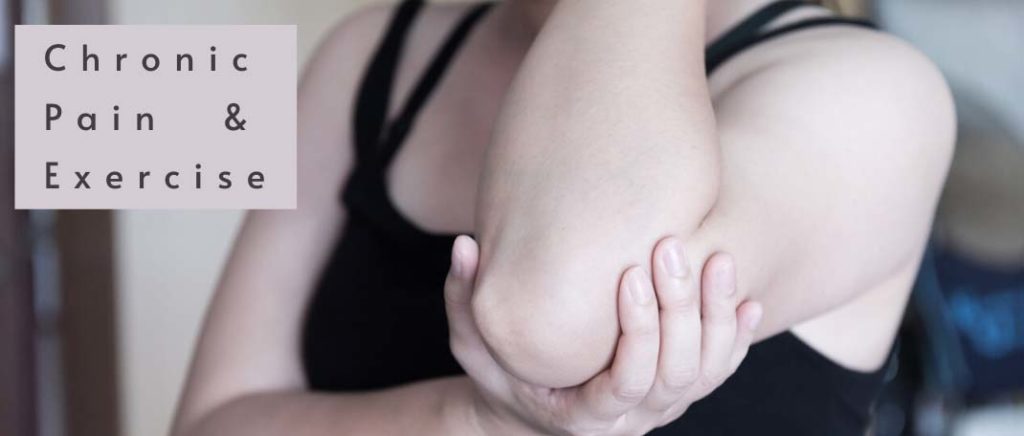
Chronic Pain And Exercise
Today we look at chronic pain and exercise. Through my years of experience as a Personal Trainer and body transformation specialist working with the general population, along with hours and hours of research on the subject, I have come to the conclusion that exercise in a supervised and controlled manner is beneficial for those that suffer chronic pain.
The 2 most common cases of chronic pain I see are lower back issues and osteoarthritis in knees and hips.
Chronic pain (also known as persistent pain) is pain that persists beyond the expected healing time of an injury.
Unlike acute pain, which is caused by tissue damage, chronic pain or persistent pain is less about the structural or tissue damage and more about the sensitivity of the nervous system and non-tissue related factors.
When it comes to chronic pain, or any pain for that matter, there’s no one single quick fix. A holistic approach to pain management may be the key to helping you move better, sleep sounder, reduce discomfort and get your life back on track.
For those experiencing chronic pain, the impact that it has on day-to-day life can be widespread; impacting all facets of life including employment, caring for children, relationships, sleep, mental and physical health and general activities of daily living. It can be debilitating and down right depressing.
“Pain” is an umbrella term used to describe a wide range of uncomfortable sensations felt in the body. No two people will experience the same pain, as each person’s perception of pain will be different.
This is why pain management that works for one person, may not work for another. What has been studied is the effect of exercise on chronic pain and the benefits of exercise-induced analgesia (EIA).
Why It’s Important To Exercise…
Research has shown that regular exercise can be an effective way to reverse the downward cycle of deconditioning and worsening pain, and gradually over time help those with chronic pain engage in more activities for enjoyment and day-to-day living with greater ease.
“Motion is Lotion!” “Exercise is Medicine!” – the body and mind love movement. Gradually becoming more active is essential for treating and managing chronic pain. Some of the benefits of exercise include:
• Your joints get nice and lubricated and glide more easily.
• Some structures including your nerves and the discs of the spine need movement to get their nutrients and be healthy.
• Your muscles get stronger and don’t fatigue as easily.
• Your nervous system winds down promoting relaxation.
• Reduced pain flare-ups.
• Your mood improves and helps with anxiety and depression.
Most importantly, your body produces its own pain relieving endorphins post exercise. These endorphins are better than any pain medication your GP can prescribe!
After a bout of exercise, your pain tolerance increases, things hurt less and this can last up to up to an hour depending on the exercise.
Exercise improves a person’s sleep patterns. Sleep problems often plague individuals that have chronic pain.
Worry, anxiety, depression or the pain itself diminishes the quantity and/or quality of your sleep. Some medications for chronic pain also encourage insomnia.
Sleeping aids can help, but practising relaxation and behavioural therapy techniques can help you get more normal sleep without the side effects. When sleep patterns improve, pain symptoms usually do too.
Physically active individuals tend to sleep longer and more deeply than those who are sedentary. Exercise also helps to alleviate sleep apnea by better regulating your breathing patterns and helping to lose weight.
Exercise Tips For Chronic Pain…
Too much of the wrong activity can make chronic pain worse. So make sure you are exercising correctly for your “training age” (the level of exercise experience that you have over time) and you are doing exercises that will help rather than hinder.
If running or jogging, for example, are out of the question or painful, you may be able to manage and enjoy cycling, which is easier on painful knees and/or hips.
Aquatic therapies, such as Aqua Aerobics performed in water, may be a good place to start.
Aquatic therapies can help to alleviate inflammation; the buoyancy of the water protects the body from the stress of gravity and from jerky or jarring movement that might otherwise cause pain.
A scientific, personalized resistance training program has been proven to induce the greatest amount of exercise induce analgesia of all.
No matter which type of exercise you choose, use caution not to move to quickly, stretch or twist to far, or do so much that your pain becomes worse.
As you become more comfortable, you may decide to enroll in an exercise class or pursue personal training; inform your instructor or fitness professional of your condition, so they can create a program that progresses you at the correct rate and that they can demonstrate how to move safely and get the most out of your workout.
All the research shows that exercise works best for chronic pain when it is delivered with education and knowledge about your condition, physical activity, and pain, so be sure to tell your fitness professional about your condition and tolerances.
For example, education and reassurance that pain does not necessarily equal further injury will help reduce anxiety. It is normal for people with chronic pain to experience discomfort and/or increased symptoms as they gradually become more active.
Guidance with acceptable and non-acceptable pain can be very helpful and reassuring. In relation to exercise and chronic pain, a motto that my esteemed medical professional network uses is “know pain or no gain” as opposed to “no pain, no gain”. (I kinda like that one!)
There is no one optimal type of exercise for chronic pain, therefore your program should be individualized, have a level of supervision that is at it’s highest at the beginning of the program and be fun!
Exercise physiologists and experienced fitness professionals, have extensive knowledge of exercise prescription for chronic pain conditions.
Generally, these professionals have longer consultations (45-60 minutes) than many other allied health professions.
This helps with client-trainer communication and relationships, which promotes better outcomes. For some people, the stress imposed by chronic pain is beyond their ability to cope, and consultations with a clinical psychologist experienced in pain management may be beneficial.
In some instances, a combined treatment approach involving a number of health professionals will be the best way moving forward.
We have an extensive network of allied medical professionals that we work with to provide the holistic approach you may be seeking.
“Exercise is Medicine” and is an important daily strategy used to assist in the management of chronic pain. |
Stretch to cool down, not to warm-up. Do short bouts of exercise not long stretches. |
It’s important to start slowly when beginning an exercise program and avoid pushing into stronger pain. It’s often useful to use a 0-10 scale to monitor your pain levels while exercising. If your pain level increase by more than 2 levels from your baseline, you should stop and modify that exercise to ensure that you don’t cause a flare up of your pain. |
Exercise in the mid-morning or early afternoon. While you sleep, your body temp drops, leaving you stiff and lacking mobility in the morning. Since mobility helps your joints move in their full range of motion during your workout, you may not perform optimally first thing in the morning. Everybody is different however, so listen to your body and talk to your accredited fitness professional for more advice. |
Always talk to your doctor and get medical clearance before commencing any exercise program. |
Choose exercises you enjoy. Resistance training (weights), yoga, walking, swimming, etc. are all OK. |
Start slowly and gradually increase your efforts as you gain strength, mobility and confidence. |
Move at your own pace. Never try to keep up with a class or group if doing so is painful. Avoid exercises that cause pain to continually spread down the arms or legs. |
Slowly pace up the exercise program by first increasing exercise volume before increasing the intensity. |
Exercise every day, if possible. Be consistent. Don’t do more on good days and less on bad days. |
Strive for a balanced routine of cardiovascular, strengthening and mobility exercise. |
Some discomfort with exercise is acceptable. |
Be patient with your progress. Over exertion makes pain worse and can strain muscles. |
Consider an exercise professional if you need help with you program. |
For more information on training with chronic pain or any other health and fitness advice, you can contact us at info@timeouttraining.com.au.
| Remember, take Timeout for Yourself & Your Health!! |
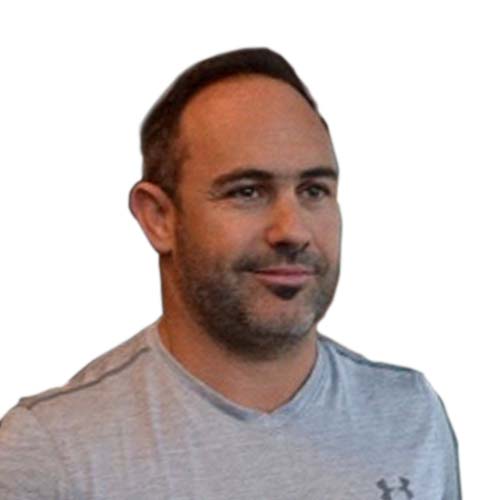
Personal Trainer
Click here to to find a practitioner.
RETURN TO FRONT PAGE
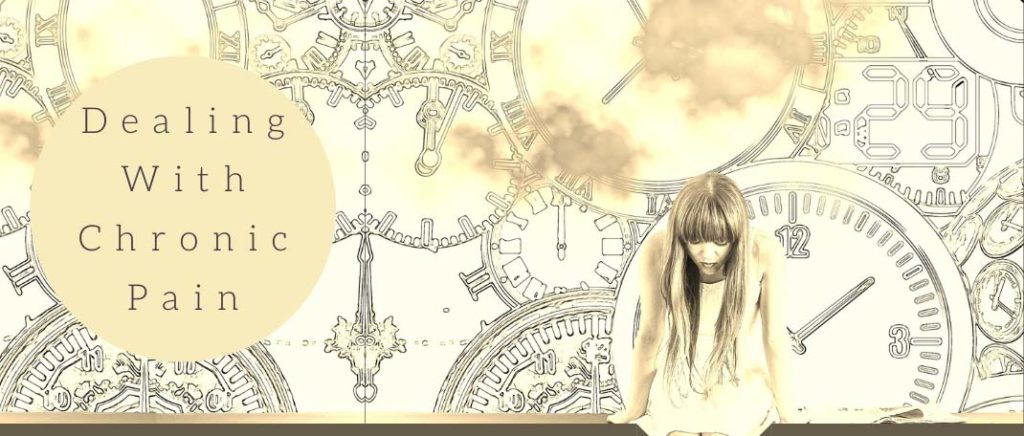
Dealing With Chronic Pain
The word ‘Chronic’ is what I want to focus on here in this article. Chronic, as defined in Wikipedia: Chronic pain is pain that lasts a long time.
In medicine, the distinction between acute and chronic pain is sometimes determined by an arbitrary interval of time since onset; the two most commonly used markers being 3 months and 6 months since onset, though some theorists and researchers have placed the transition from acute to chronic pain at 12 months.
So, what does this mean in real terms when working with our own, or with our clients’ chronic pain?
It generally means that we will need to work with them for an extended time or arrive just at that moment when the timing is just right for us to ‘shift’ the pain. This is what happened for me and you can read about it further on in this article.
1. The need to help them recover (quickly). |
2. The need for some patience and empathy. |
Each one of these has it merit and each one has lessons to teach. What I do with patients who come to see me as a counsellor, rather than as a body worker, with their pain issues is, I get them to ‘go into the pain’ and to gesture what the pain feels like.
I get them to show me with their hands and their body, through painting it, or by sculpting it with clay. I often get them to express the sound of the pain and the injury.
Working with pain, for me, must include releasing it through the emotions in some way too. Oftentimes the injury (and the pain) is a trapped emotion – sometimes many years old and simply cannot be shifted with body work alone.
The combination of emotional release work and body work is an effective way to go.
Many years ago, I had a back injury – I tore my L5 and it was quite a long journey working through it all. Some days I was in no pain and could move very freely and on other days I could barely straighten my back and walk.
This went on for several months. The most challenging for me was that I could not determine when the pain would come. With my personality of being a go getter, I sometimes found myself in agonising positions shortly after doing something that I felt I could do easily.
I remember once making a big pile of compost with straw, weeds, cow dung and other materials.
I was happily shovelling and mixing when suddenly I was hit with a several bolt of pain in my lower back reducing me to a curled-up mess on the floor with tears flowing down my face. It was severe.
The emotional effects of this were quite deep. I really thought that I might have to have surgery. I had moments where I envisioned being in a wheel chair for the rest of my life.
These times were not easy, and it took a lot of strength for me to stay focused. These thoughts did not come often, but when they did they were powerful.
I had a wife and three small children to look after and I wondered how I would manage with that too.
Because it was an injury that could not be physically seen, like a broken arm in plaster, it was, in my own mind, and perhaps also true in some cases, dismissed as not being real.
I even had an insurance investigator pose as a man interested in organic farming who came to my farm to join our study group.
It was interesting, as some days when he came I had no pain and could do some work around the farm. On other visits he would see me in pain unable to move off the chair.
I am not sure how he reported this to his insurance boss. I was on workers compensation for a few months and was getting hydro-therapy, massage and other treatments which all worked to keep the pain level low most of the time, but the severe pain did continue to hit me from time to time.
What really helped me was my meditation practice and the knowledge that I would not take any drugs. Even when the pain threshold was at breaking point, I still choose not to take any drugs.
I wanted to work through the emotional component as well as the physical and I knew that any drugs would numb this.
My pain relief was lessoned by using a ‘TENS machine’, having regular massages and doing lots of hydro-therapy and swimming, as well as receiving some Bowen and Alexander technique work.
About two years after the initial physical injury, I was at a weekend workshop and a man called Warwick, who was a body-worker, saw me stretch in pain as we broke for morning tea and offered to give me what he called ‘A Korean Accu-Pressure Massage’.
It was like Trigger Point Massage. At lunch time he worked on me for about 15 minutes, mostly on my spine.
I was also aware that I was in a workshop called ‘Freeing Up Finances’ and that my back issues were connected to that.
The workshop was pushing a few old emotional buttons from my childhood and my connection – or disconnection, to wealth and I was feeling it in my body; in my lower back.
This block to wealth had been worked on previously in several ‘energy healing’ sessions so I was aware of what it was all about. For me, there is always an emotional connection to anything physical going on in the body.
In the workshop I was addressing some of these old blockages and really felt that they were ready to be shifted for good.
The place, person and treatment to help shift it out of my body was presented to me and I was open for it to happen. After this one short ‘back massage’ I stood up, and something had really shifted. It was incredible.
In that moment I felt taller. I felt freer. I felt liberated. Since that day I have only had a few minor twinges in my lower back and have not once had anything like the severe pain that I had experienced previously.
A positive message to carry forward. So, as I know from my own experience and from working with many people in my work, chronic pain can arrive out of the blue and then move out of our body just as quickly when the right moment, person and treatment arrives.
Sometimes this happens when least expected, so be open to it if you are currently in pain and see what arrives for you.
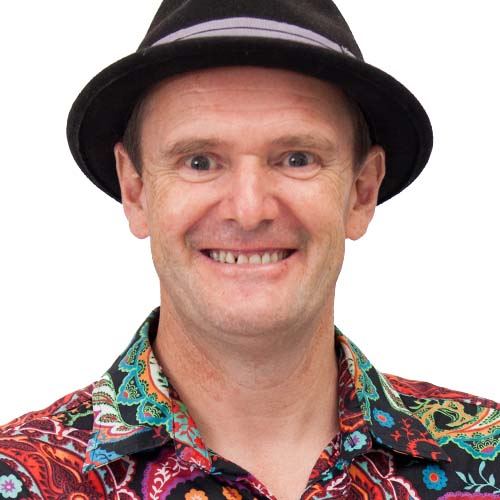
ADRIAN HANKS
Life Mastery Coach
Click here to work with me.
RETURN TO FRONT PAGE
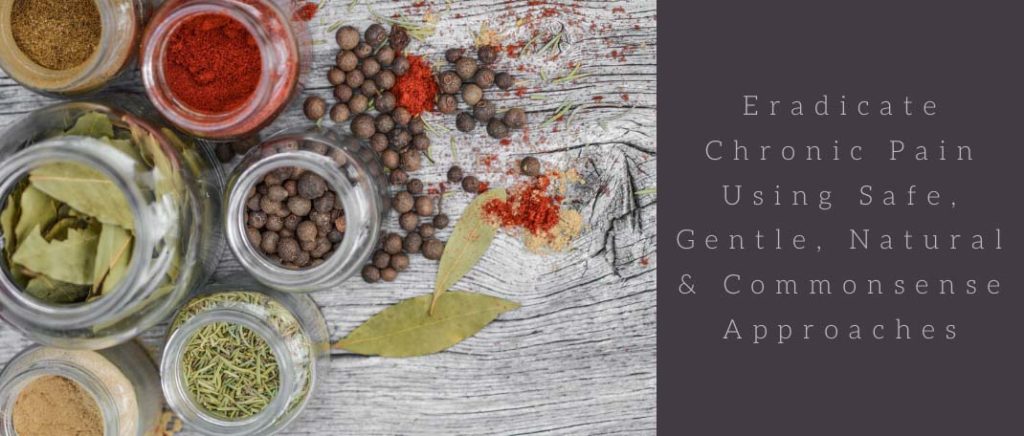
Eradicate Chronic Pain Using Safe, Gentle, Natural & Common-Sense Approaches
Millions of people worldwide now suffer with chronic pain, both as a symptom of other conditions and as a primary condition. There are typically various underlying causes.
However, as with most modern chronic diseases, there is almost always a single common denominator: inflammation.
Chronic inflammation and “auto-immunity”, as it’s sometimes called, does not just occur because the body is confused and attacks itself like a rabid dog, which is the impression we are sometimes given by well-meaning physicians.
And taking medications to reduce inflammation, whilst incredibly helpful for reducing suffering in the short term, will not offer anything in way of a cure.
It is important to understand that if you are chronically inflamed, then there will almost certainly be a number of underlying factors which need to be addressed, especially relating to the endocrine, nervous, immune and digestive systems.
Before we get into the specifics of how to address some of these underlying causes, let us start off by addressing the single most important factor when it comes to reducing inflammation: diet.
One thing is clear: excessive intake of carbohydrates in the diet massively exacerbates systemic inflammation, regardless of the underlying causes.
In other words, whatever started the fire, carbs and sugars act as petrol. I cannot emphasize this point strongly enough. Many of you may be tempted to stop reading right now, appalled at the very idea of doing without your carb fix, but I urge you not to.
All of us, to some extent, have a carbohydrate addiction and cutting down on carbs requires dedication and determination.
However, it is the single greatest thing you can do to reduce inflammation in your body and if you are successful, and there are many ways to increase the chances of success, I promise that you will never regret it or wish to go back to your carb addiction!
Indeed, the research is clear: a nutritional ketogenic diet with intermittent fasting has tremendous benefits for fighting inflammation, balancing the endocrine system (thanks to a reduction in insulin spikes for example), healing the nervous, immune and digestive systems and more.
Some pioneers in this area of research are Dr. Marco Ruggiero, who has made ground-breaking progress in the treatment of cancer, autism and AIDS, and Dave Asprey, founder of the “Bullet Proof Diet”, amongst others.
Dave Asprey, in particular, highlights the importance of identifying and completely avoiding food allergens, which he believes, play a significant role in systemic inflammation.
There is even a handy app called the “Food Detective” that helps you identify food allergens straight away, by monitoring your pulse after eating. When exposed to a food allergen, the first symptom is a raised pulse. Check it out.
Ok, so you change your diet, you start to feel better… better than ever in actual fact, but you still have a few aches and pains. What else, besides diet, can you do to help your body heal.
Well, the good news is that there are lots of additional things that can be done, and as it is taught in Ayurveda, the traditional system of medicine from India, unless the diet is right, no other medicines will be truly effective.
So if you’ve already improved your diet, now is the perfect time to consider additional support. For example, it is especially important to support your digestive system, liver and kidneys.
To anyone serious about remaining well in the modern world, I recommend the daily intake of a hepatoprotective agent such as Milk thistle or Calcium d-glucarate. (I take both!)
I also drink Dandelion tea and take digestive bitters containing Gentian to stimulate bile flow and increase gut motility.
Many of you may need a little help producing sufficient stomach acid, so you may like to consider supplementing with betaine hydrochloride before meals. All of these steps make a huge impact on digestive health.
It is also highly beneficial to support the health and integrity of the gut lining, which is almost always compromised when there is systemic inflammation.
Eating foods rich in zinc such as lamb, oysters, pumpkin seeds or taking a zinc supplement daily can do wonders to promote a healthier gut (if taking zinc in supplemental form, opt for zinc gluconate and make sure it is balanced with its partner copper).
Combine this with plenty of glutamine-rich foods, such as cabbage and other cruciferous veggies and collagen from bone broth or in supplement form and just watch in amazement as your gut starts to feel amazing and your aches and pains start to dwindle.
I am a staunch advocate of the daily consumption of probiotics. I don’t think buying capsules is very effective because the latest research shows that without the substrate in which the bacteria grow, the benefits of probiotics are almost entirely lost.
So save yourself the extra expense and invest in a kefir kit. You can make fresh kefir at home daily. Its dirt cheap and 1 glass of fresh kefir likely contains more useful bacteria than the entire pot of probiotics you just bought for twenty dollars!
Another very important factor is the endocrine system, aka your hormones. When we are chronically stressed, our cortisol levels will be dysregulated; with levels often being too high during times of acute stress, and levels dropping far too low when we get a breather.
This roller coaster ride has all kinds of problems associated with it, not least of which is… you guessed it: inflammation.
Cortisol is actually the body’s primary anti-inflammatory steroid hormone. It is why they give you hydrocortisone shots at the hospital. When levels are too low due to chronic stress, you get severely inflamed.
So how do we support our endocrine system, especially the HPTA (Hypothalamic-pituitary-thyroid-adrenal) axis?
First, we want to make sure we are getting enough of the master mineral: magnesium. In fact, magnesium deficiency alone is possibly the single greatest contributing factor to chronic disease today.
It is estimated that over 85% of those living in developed countries are moderately to severely magnesium deficient.
If you have chronic pain, you are almost certainly deficient too. There are many different forms of supplemental magnesium, ranging from magnesium oxide and citrate (which you want to avoid), to better forms such as magnesium threonate, bisglycinate and chloride.
My personal favourite is mag chloride powder. Not only is it cheap to buy and contains no fillers, it also does not have a laxative effect if taken in therapeutic doses.
Under times of stress, I often take up to 6-7 grams of mag chloride powder a day. That is about 830mg of elemental magnesium, significantly higher than the RDA.
Dr. Carolyn Dean MD, ND in her book “The Magnesium Miracle” states how therapeutic doses of magnesium are often required to get levels up in such a stressful and toxic world.
On the subject of minerals, it may be a very good idea to get all of your mineral levels checked by a holistic physician.
Alongside magnesium deficiencies, it is incredibly common for people suffering with any ill health to have a number of other mineral deficiencies.
The good news is that there are supplements and foods you can start consuming right away, which will start to bring lots of bioavailable minerals back into your tissues and bones.
Some of my favourites include kelp (capsules), sea weeds such as nori, kombu, etc, Cornish or pink Himalayan salt, samphire, wild lamb and game and shilajit (mineral pitch).
Other supplements I highly recommend are food state B vitamins (bee pollen is an excellent source), full spectrum vitamin C (lemons, grapefruit, camu camu, etc.) and fermented cod liver oil.
I don’t recommend taking vitamin D3 supplements on their own. Vitamin D needs to be balanced with its partner vitamin A. Cod liver oil contains both, as does grass-fed butter. Our grandparents knew what they were doing!
On top of that, if you want some additional anti-inflammatory support, there are a number of natural remedies to turn to.
Some of the most potent pain relievers are turmeric, ginger, omega 3 EFAs (coder liver oil contains plenty), Harpagophytom procumbens, frankincense, German chamomile and lavender essential oils, to name a few. However, these remedies are not cures.
They are only treating the symptoms of chronic pain and inflammation. To truly heal the causes of the pain, it is necessary to make several fundamental lifestyle changes as highlighted above.
I wish you all the best of health!

Nutritionist
Click here to to find a practitioner.
RETURN TO FRONT PAGE
|
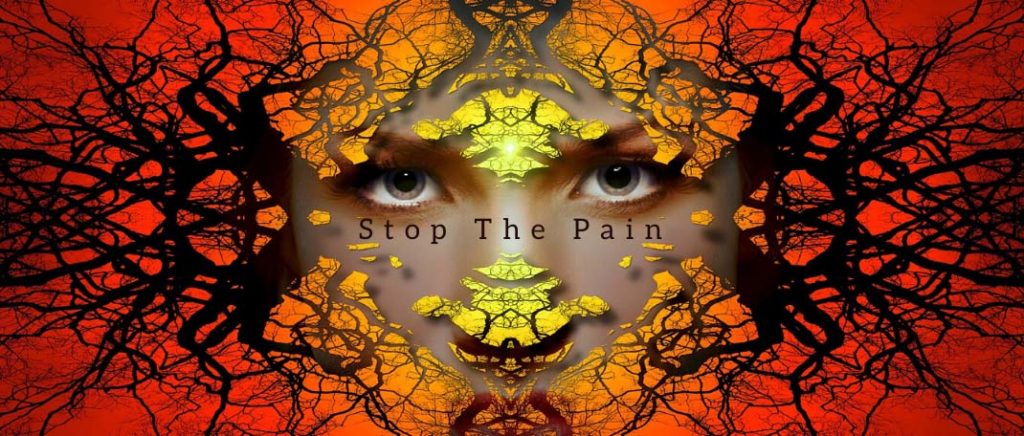
Stop The Pain. I’m In Hell!
Chronic pain has become an epidemic in modern society. It very quickly diminishes the quality of life. It becomes very challenging to complete even simple tasks.
When you are in pain you become self-absorbed. It is difficult to focus your attention on any task and you cannot give your very best to the most important things in life.
This includes exchanging love and affection with your love ones, household essentials and performing work at the optimal level. In the 21st century we do not have time for pain.
Everyone is so stressed and rushed with life that we tend to look for a quick fix. Sometimes this works and often it does not.
Sometimes a quick fix like aspirin or other anti-inflammatories can temporarily reduce the pain so we can function. It is very important however to truly identify and embrace the cause of your pain.
If, for example, your pain prevents you from having a good night’s sleep it becomes a compounded problem, as the lack of sleep often gives the pain a stronger grip over your immune system.
Emergency Pain & Western Medicine
The ultimate solution for treating pain is often a combination of Western medicine and alternative medicine.
If you are in intense pain due to injury or an unknown cause, then get yourself to the hospital emergency room as quickly as possible. Get a professional opinion.
They may treat the symptoms temporarily to give you some relief, before authorising tests to find the actual cause. Listen to what the doctors tell you to do to get yourself out of hell.
When the pain is substantially reduced you will be able to think more clearly in order to create and implement short term and long term plans to have better health.
Physical pain is often psychosomatic. This means physical symptoms or illness that originate in the mind. The word psyche means mind or soul and the word soma means body.
So once you get yourself “out of emergency mode” with pain, it is time to look at everything else.
This is not something that you want to do alone. Don’t mess around with your health. Without great health, and a high vibration of energy you cannot fulfil your destiny.
Chronic Pain – Integrative Medicine For The Biochemical Component
Since all pharmaceuticals have side effects it is best not to use them as a long-term solution. Temporarily they can save your life, but over the long haul they contribute to taking away the quality of your life.
One incredible way to bridge western medicine with alternative medicine is to locate an excellent integrative medical doctor. This way you have the best of both worlds.
He or she will take extensive tests that combine analytical considerations from many different perspectives.
Their primary objective and purist intention is to balance the treatment of cause and effect. The long term plan will be to eliminate the cause of the problem. The short-term plan will be to bring you relief from the symptoms as quickly as possible.
This type of thorough testing and time required by the doctor is more expensive and often not covered by health insurance. If it is affordable you would often be purchasing nutritional supplements online.
I-herb.com is one good example because they have a wide range of products and you can buy the product in bulk to save money. There are many other excellent supplement companies and they are just one example.
With regard to chronic pain the underlying cause of serious illness and even not so serious illness is usually inflammation. Since this builds up overtime it will often take a while to balance the acid and alkaline condition of your body.
Your doctor will tell you whether or not you’ll need anti-inflammatories in the short-term.
If an integrative medical doctor is either not affordable or not available for you look for an excellent naturopath or nutritionist. They can assist you in prioritising the correct diet, supplements and exercise for your inflammation.
I highly recommend the book “Earthing” by Ober, Clinton and Sinatra. This is an inexpensive way to ground yourself and strengthen the adenosine triphosphate found in every cell of the body.
By walking on the earth, grass or along the beach you can literally transform your health and balance your entire energy system including alkalizing the body.
Another inexpensive way is to take a teaspoon of baking soda in a little bit of water three times a day until the pain is gone. Then as a maintenance cut back to 1 teaspoon a day.
If you’re very sensitive to the product then begin with a half teaspoon three times per day.
Another great supplement to fight inflammation and pain is high doses of vitamin C. You can begin with 500 mg every hour and then build up to 5000 mg overtime unless you get diarrhea.
If this happens you must reduce the amount of vitamin C until your tolerance level permits you to take more. Vitamin C fights infection and inflammation.
You already know this but eat organic foods whenever possible. Eliminate processed foods completely from your painful body because it is screaming out for quality.
You deserve this and so does everybody on the planet. But you can only begin with yourself and your loved ones.
Depending on your unique situation and the cause of your pain, infection or inflammation you can use many additional herbs and supplements to support your recovery.
One tip that can save you a lot of money is to find a professional practitioner who understands nutritional kinesiology.
You can take a list of supplements or take the actual supplements themselves and have the practitioner of kinesiology or a chiropractor muscle test to determine the supplements that your body needs.
You can test the amount, the frequency, or the brand of a given herbal supplement that has been prescribed to you by your doctor or alternative practitioner.
Nutritional kinesiology is excellent because it allows you to monitor and adjust the supplements you really need from day to day and can save you hundreds of dollars by eliminating supplements that do not really work for your body and provide an accurate indication of when you can cut back on, or eliminate other products from your diet.
Last but not least and possibly the most important is the volume and quality of the water that you drink. It must be filtered from toxic chemicals including fluoride and chlorine.
If possible drink 8 glasses of alkaline water per day and use it for everything including brushing your teeth, making tea or smoothies.
Alternative Medicine For Your Body-Mind-Spirit Component
Whatever you do – do not overlook the mental, emotional and spiritual components that contribute to your chronic pain. Neuro scientists have proven that the mind and body is not only connected but it becomes interconnected through your neuropeptides.
A simple example would be a tear. It is an emotional expression that manifests in a physical way.
Could it be that your chronic pain wants to cry too? Could it be that you are using too much of your energy to hold down anger? Could it be that the suppression of this anger toward yourself, your life or others is the primary fuel for your stress?
And that the suppression of your immune system, along with an acid based diet, leads to your inflammatory response and chronic pain?
Whatever negativity you’re holding onto from the past is being emotionally held in every cell of your body and creates toxicity that will not go away. It must be confronted in a healthy manner.
It must be transformed in such a way that your entire body-mind system becomes free from the past so you can live in the present moment with true freedom, spontaneity and self-love.
Find yourself an excellent body-mind practitioner who can safely guide you through the transformation of negative emotions being held within your body-mind; that includes resentment, guilt, shame, negativity, self-judgment and anger.
With the cleansing of these negative emotions goes the freedom to love yourself and others that you have a longed for and deserved your entire life.
When you love yourself and prioritise your health on all of these levels you earn a get out of hell free card and will say goodbye to all your chronic pain.
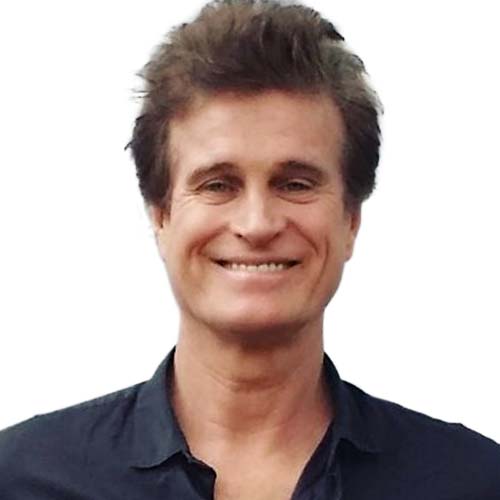
ROBERT KIRBY
Mind/Body Transformation & Integration Expert
Click here to work with me.
RETURN TO FRONT PAGE
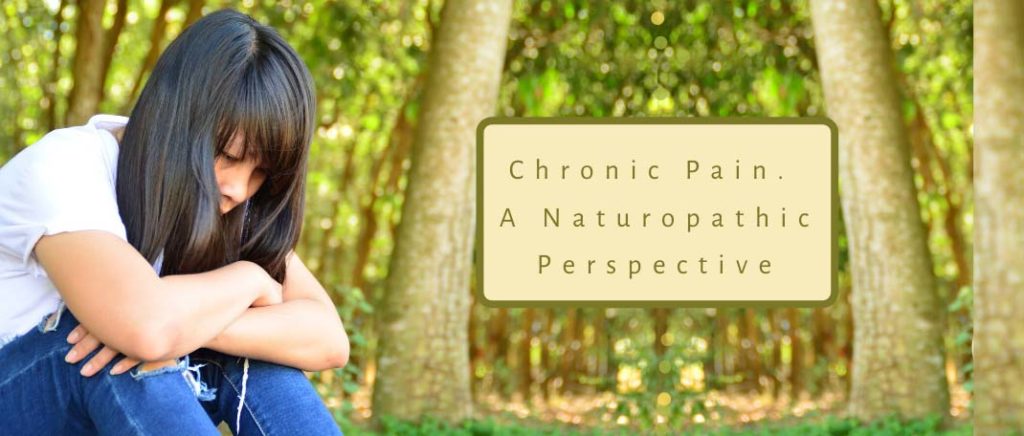
Chronic Pain. A Naturopathic Perspective
Chronic pain can be anything from mild to severe. It is different from acute pain. Acute pain is pain from an injury, which happens quickly and doesn’t usually last for long. Chronic pain, affects one in five Australians.
People with severe, chronic pain know how it can utterly disrupt and damage one’s life. Chronic pain refers to pain that does not improve with time.
Regardless of the location or cause of chronic pain, many patients develop difficulty functioning in daily activities.
Pain affects every aspect of life. Chronic pain can make it hard to work, take care of yourself and do the things you enjoy.
It can also affect your sleep and mental and emotional health increasing your stress and frustration, sapping your motivation and activity levels, and contributing to fatigue.
All pain is real contrary to what some people believe. One may think that this is obvious, but people with chronic pain are sometimes treated as if their chronic pain is either imaginary or exaggerated.
The more severe the pain, the heavier a toll it takes on your well-being. Chronic pain gets worse as changes in your body make you more sensitive to pain.
A complication in getting care is that everyone experiences and expresses pain differently. Two people with the same injury will feel and show their pain in a unique way. For example, things it can depend on;
• The circumstances in which the pain occurs
• Thoughts about the chronic pain, such as “this is nothing serious” versus “this pain could kill me”
• Emotions associated with the chronic pain, such as depression and anxiety versus hopefulness and optimism
• Cultural influences leading a person to be more stoic or more dramatic in showing pain to others
Coping With Chronic Pain
Pain management for chronic pain requires a multi-modal approach. Different things work for different people. Below are some modalities to try.
Pace Yourself – Pacing activities throughout the day and giving yourself time to rest is essential. The focus is on doing what you can do, when you can.
Reduce Stress – Stress may intensify chronic pain. Reducing stress in your life is essential in managing pain.
Eat Well – Eat a healthy diet. Eat plenty of vegetables, fruits, whole grains, nuts, and legumes. Avoid processed foods, especially those loaded with salt or sugar. Keep an eye on portion sizes to help avoid weight gain.
Include the following as natural pain killers: Turmeric as a natural pain reliever because it helps relieve inflammation. Add a teaspoon to a curry or a glass of warm water or have as a Turmeric latte.
Wasabi is a spicy food with natural painkilling properties add to fish. Ginger fights off pain with its anti-inflammatory properties.
Add ginger to meals and juices. Caffeine can reduce pain in those suffering from exercise-induced muscular injury and pain. Tart cherries contain antioxidants and anti-inflammatory compounds in the fruit.
Add a handful to your daily juice or fruit salad. Extra-virgin olive oil has a compound called oleocanthal, and it works like ibuprofen.
Add a tablespoon to your daily diet. Apple cider vinegar has been a home remedy for thousands of years. It has also been used to manage pain and reduce inflammation.
Coconut oil has some natural antimicrobial and anti-inflammatory properties, add it to smoothies. Chilli peppers contain capsaicin.
This spicy compound depletes pain compounds to block pain signals, works as an antioxidant. Red, purple, and blue fruits contain anthocyanins, antioxidants and anti-inflammatories that reduce pain and swelling.
They also fight cholesterol. Try blackberries, cherries, strawberries, raspberries, blueberries, cranberries, and red grapes.
Include leeks, shallots, onions, and garlic all contain pungent sulphur compounds that reduce inflammation.
Include Omega-3 Fatty Acid Foods Include; flaxseed oil, fish oil, chia seeds, walnuts, fish roe (eggs), fatty fish, seafood, oysters, soybeans, and spinach. These “good fats” lower inflammation.
Stay As Active As Possible – Walking, swimming, Qigong, and dancing. A physical therapist can help you develop a regular exercise plan that you can stick with—one that isn’t overwhelming.
Mind-Body Therapies – Participate in meditation, yoga, and tai chi, these therapies can help in coping with pain.
Acupuncture – This ancient Chinese medical practice seeks to relieve pain by balancing the body’s natural energy pathways. Results from a number of studies suggest that acupuncture may help ease types of pain that are often chronic.
Breathing Exercises – Slow, deep breathing to release tension from muscles and relieve pain.
Cognitive Behavioural Therapy (CBT) – A type of talking therapy that combines cognitive therapy (examining the things you think) and behaviour therapy (examining the things you do) and focuses on how thoughts, beliefs and attitudes affect feelings and behaviour and aims to teach coping skills to help deal with problems.
Energetic Medicine – Tennant Biomodulator® uses Biofeedback and Neuromodulation technology designed to stimulate the body’s natural release of nitric oxide, endorphins, and neuropeptides into the blood stream, and increases ATP (voltage) in the cells.
The Biomodulator works by giving the cells the energy they are lacking. When the cells are restored to their optimal level of voltage the body can heal itself. Nitric oxide causes vascular dilation and thereby increases blood circulation.
This is very effective in managing pain.
Progressive Muscle Relaxation – In progressive muscle relaxation, you tense a group of muscles as you breathe in, and you relax them as you breathe out. You work on your muscle groups in a certain order.
Visual Imagery – Visual imagery involves concentrating on mental pictures of pleasant scenes. For example, a tropical beach, forest, or events. Visual imagery involves creating a detailed mental image of a place where you feel at peace.
Picturing something in your mind and actually doing it are experienced as the same thing by your brain. In fact, brain scans have verified that this is the case.
Visual imagery can have a direct effect on your nervous, endocrine, and immune systems. Soothing, peaceful images can slow your pulse and breathing and lower your blood pressure.
They also trigger the release of endorphins. Endorphins interact with the receptors in your brain that reduce your perception of pain. Endorphins also trigger a positive feeling in the body.
Transcutaneous Electrical Stimulation (TENS) – Therapy uses low-voltage electrical current to relieve pain.
The electrical stimulation helps the body block pain signals from travelling to the brain and assists in the production of natural painkillers called endorphins.
TENS therapy is a drug-free, non-invasive, and fast means for pain-relief that has been used in clinics for decades. TENS therapy made its way into patients’ homes after it was adapted from a clinic machine to a hand-held unit for patients to use anywhere.
Trauma Release Exercises (or TRE®) – TRE® is a self-empowering trauma recovery process. It’s also known as neurogenic tremors.
It consists of simple yet innovative series of exercises that assist the body in releasing deep muscular patterns of stress, tension, and trauma.
The process involves four stages: first a set of movements and exercises that work on particular muscles groups to create a modest amount of tension through those muscles. This tension invites the body’s natural tremor response.
Secondly, there is a period of tremoring (and the tension is reduced).
Thirdly, we stop tremoring; in fact, one of the first things we do when we learn to begin tremoring is how to stop.
Finally, we rest and integrate the effects. When this muscular shaking/vibrating mechanism is activated in a safe and controlled environment, the body is encouraged to return back to a state of balance.
Practice Relaxation – Sit quietly, read, write in a journal, or listen to soothing music.
Sleep Hygiene – Chronic pain has a significant impact on sleep. Turn off all bright screens (computers, smartphones etc.) 1 – 2 hours prior to bed. Drink a cup of chamomile tea 30-45 minutes before bed.
If you have tried and failed to improve your sleep, talk to your health care professional for help.
Distract Yourself – Call a friend, go to the movies, visit family, pursue a hobby.
Depressed – Although depression can further debilitate people with chronic pain, these people may be less likely to recognize and talk about symptoms of depression with their doctor. If you feel depressed, talk your health care professional.
Be Strategic About Medications – Talk to your health care professional about timing if you are taking medications and what natural herbs and supplements you can take.
Chronic pain affects all areas of an individual’s health, therefore using more than one modality is beneficial in managing chronic pain.
If one or more modalities do not work for you try another, or a combination. Understanding that chronic pain is an ongoing issue that needs to be managed.
• Sleep hygiene. https://sleepfoundation.org/sleep-topics/sleep-hygiene |

IRENE VERVLIET
Naturopathic Doctor
Click here to find a practitioner.
RETURN TO FRONT PAGE

I Am Love
I wonder sometimes what we might truly discover if every one of us paused for a moment from our busy everyday lives to think about what it is to be human.
Would we contemplate the miracle of the human body and how it subconsciously performs all the complex and highly intricate tasks that keep each of us alive?
How do we breathe, how do we see and feel and what has to happen at a cellular level in mind and in body to keep us active, healthy, mobile and in a constant state of homeostasis?
Do we ever think about the myriad of chemical reactions that occur every second in each cell to create and co-create the right conditions to enhance physical, neurological, and emotional capability?
Is it conceivable that the human body consists largely of water – between 50% and 75% depending on a number of individual variables?
How do we actually make sense of memory, intelligence and language and what actually defines the boundaries of our reality and our imagination?
How do we think, what do we think about and how do we relate emotionally to what we think?
Do we consciously adapt and evolve our emotional intelligence based upon what we continue to learn about life and our experience of living – and, how do we weigh the importance of emotional intelligence as a principle source of energy for sustainable health and wellbeing?
I wonder if we would ever conclude that something like chronic pain could simply be an accumulation of toxic energy.
Scientists will tell you that everything is energy – and they are probably right. On this basis, we can conclude that feelings are energy, our actions create an exchange of energy and our thoughts are the creative energy that shapes our worlds of reality and imagination.
Thoughts, just like all energy, can therefore be positive or negative, creative and destructive, harmless or toxic. With this in mind, perhaps the miracle of our freewill to think whatever thoughts we like becomes the difference between health and disease.
Is it conceivable that positive thought creates positive outcomes and negative thought creates negative outcomes?
In one of my previous articles entitled ‘The Flowering of Human Consciousness’, we discussed how in 1885 Margaret Watts-Hughes used the energy of her Welsh Soprano vocal range as an instrument of creation singing musical notes into a device of her own invention called an ‘eidophone’.
The eidophone converted the many vibrations of her voice into different images when perhaps for the first time in modern history a definitive scientific association between energy and language was actualised into visible reality.
Margaret’s research findings showed the potential power and potency of human thought when expressed as language to create material form.
In a similar scientific vein of equal brilliance, Dr Masaru Emoto’s work on the exposure of pure water crystals to positive and negative language demonstrated once more the beauty and power of vibration.
Throughout his extensive research between 1994 and 2008, he observed how the use of positive energy of the invisible word formed beautifully shining hexagonal crystals.
In the case of negative exposure, crystals of identical source became discoloured, disfigured and adopted unrecognisable form.
Dr Emoto photographed much of his work and this can be viewed in various places today. Of his photography he said ‘I hope it is enjoyed as a new type of art.
Nevertheless, the world it shows is truth, and there is no doubt that many messages essential to our lives are hidden in it.’
Remembering for a moment that our human form is materially between 50% and 75% water, I wonder if we will ever appreciate the truth and purity of thought in consequence to that which we create and co-create together. A pause for thought perhaps.
The beauty and power of language became very important to me on a sunny day in August 2009 when quite unexpectedly out of the blue a series of events would change the fabric of my life forever.
Everything I knew, or thought I knew, was turned inside out and upside down when my lovely wife Carole was diagnosed with terminal brain cancer and severe epilepsy. This is where my journey into holistic health really started.
Within an hour of being told she had less than five years to live, Carole turned to me in a hospital corridor and whispered a few words that would break my heart a million times over and heal it again and again and again with the energy of her presence.
Her words speak for themselves. ‘It could be much worse. This could be happening to one of our children’, she said.
With perhaps the only words that could ever make a world of difference, Carole had managed to transform a milestone of life into an eternal moment of love – love personified in her thoughtful and intricately beautiful use of language that now spans both time and space and everything in between.
Throughout the next two and a half years, Carole and our two children became my teachers and we became each other’s mirror. Carole and I changed our thought processes and this changed the language we used and our language changed our behaviours.
Very quickly the energy of life and love found new resonance in every moment of introspective and reflective beauty that would become the OK real in our new reality.
Carole forgave herself for having to leave us all so soon and we presented this back to her in the mirror of her own image without fear and only ever with the resounding energy of unconditional love.
At the time, we just did what we thought was right, what felt right in our celebration of life and this continues to shine a light on everything – even in the darkest moments.
It keeps me safe in the knowledge, embrace and vibration of eternal love.
Grief, bereavement and any form of emotional loss can cause chronic pain beyond that which we ever think possible.
Negative emotions and emotional responses will challenge, complicate and test us to the point at which we realise the pain of doing nothing is greater than the pain of doing something.
Ironically, the energy of love can be as destructive as it is creative, relative to the circumstances in which we find or lose ourselves, until we take emotional control of our thoughts to begin a new journey.
How we chose to think about pain and the internal toxicity of emotional pain, whether it be real or imagined, can make a world of difference to our health and wellbeing.
When I look back, I now know that I had the greatest teacher for the words Carole found have proven again and again to be the beautifully shining crystals that paint a picture of health inside my body to be inflected and reflected in the waters of our emotional intelligence.
So I wrote a book called ‘Dreams, Rainbows and Butterflies’ to share Carole with the world in the hope that the energy of her words and the inner-giving of our experience may somehow be helpful.
The most beautiful words ever spoken to me were not the words in the hospital on our sunny August day of difference.
On a separate occasion, Carole was both orator and architect and spoke them to me with her quintessential beauty under a very different set of circumstances.
Circumstances that would simply reunite me with an amazing journey into the flowering of super-human consciousness – and that, as they say, is another story.
In contemplation of the positive beauty and powerful healing energy of language, our gift from Carole.
| I am not who but how and when, I am not tell but show and do, I am not life or death, I am your teacher, I am love, X |

Author, Dreams Rainbows and Butterflies
Click here to to find a practitioner.
RETURN TO FRONT PAGE
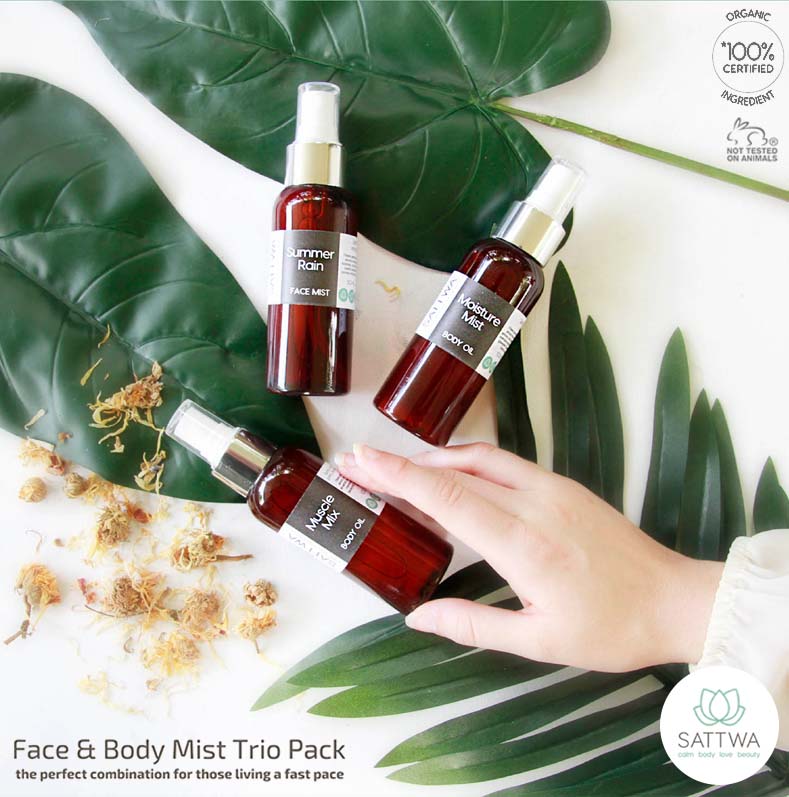 Rejuvenation Pack · LOVINGLY MADE IN AUSTRALIA · |
| What’s Chronic Pain? – Frequently Asked Questions | ||||||
|
Wordseach Puzzle[game-wordsearch id=”51982″ ] |
NEED MORE CUSTOMERS OR CLIENTS? ADVERTISE in this magazine. |
Have You Seen These Features • The Holistic Healing Portal  |

RETURN TO FRONT PAGE






